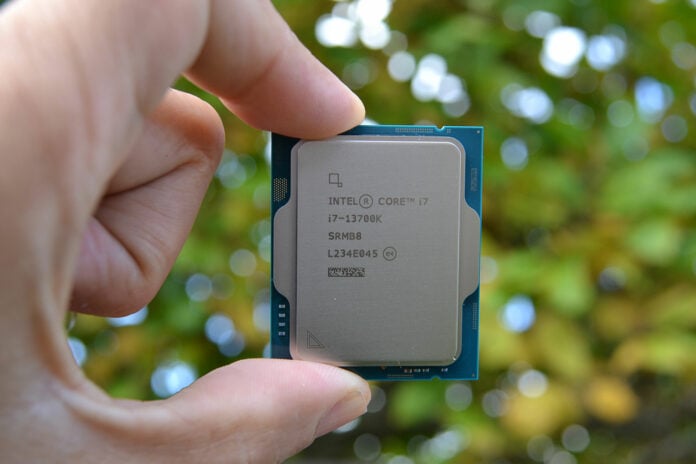Team Blue is on a roll with 13th Gen Core chips previously codenamed Raptor Lake. The Big Stick™ Core i9-13900K has proven to be an adept multi-core performer and offers best-in-class gaming potential. Our current favourite CPU, Core i5-13600K, mixes fantastic speed with a keen ticket price. Potent enough to beat out any 12th Gen Core chip in gaming, application performance is on par with Core i9 from that generation.
All that’s missing is a Raptor Lake i7. Answering that call is the 16-core, 24-thread Core i7-13700K priced at $409. Read on to find out if it’s as good as the two stablemates, but before we spill benchmark numbers, here’s everything you need to know about 13th Gen Core from an architecture and implementation viewpoint.


Intel Core i7-13700K
£399 / $409
Pros
- Great performance
- Excellent value
- Wonderful gaming CPU
- DDR4/DDR5 support
Cons
- Heightened power
Club386 may earn an affiliate commission when you purchase products through links on our site.
How we test and review products.
Appreciating 13th Gen Core uses the same hybrid-architecture as its immediate predecessor, it’s illuminating that performance gains are achieved without moving from the Intel 7 10nm Enhanced SuperFin process used on Alder Lake.
Alder Lake On Steroids
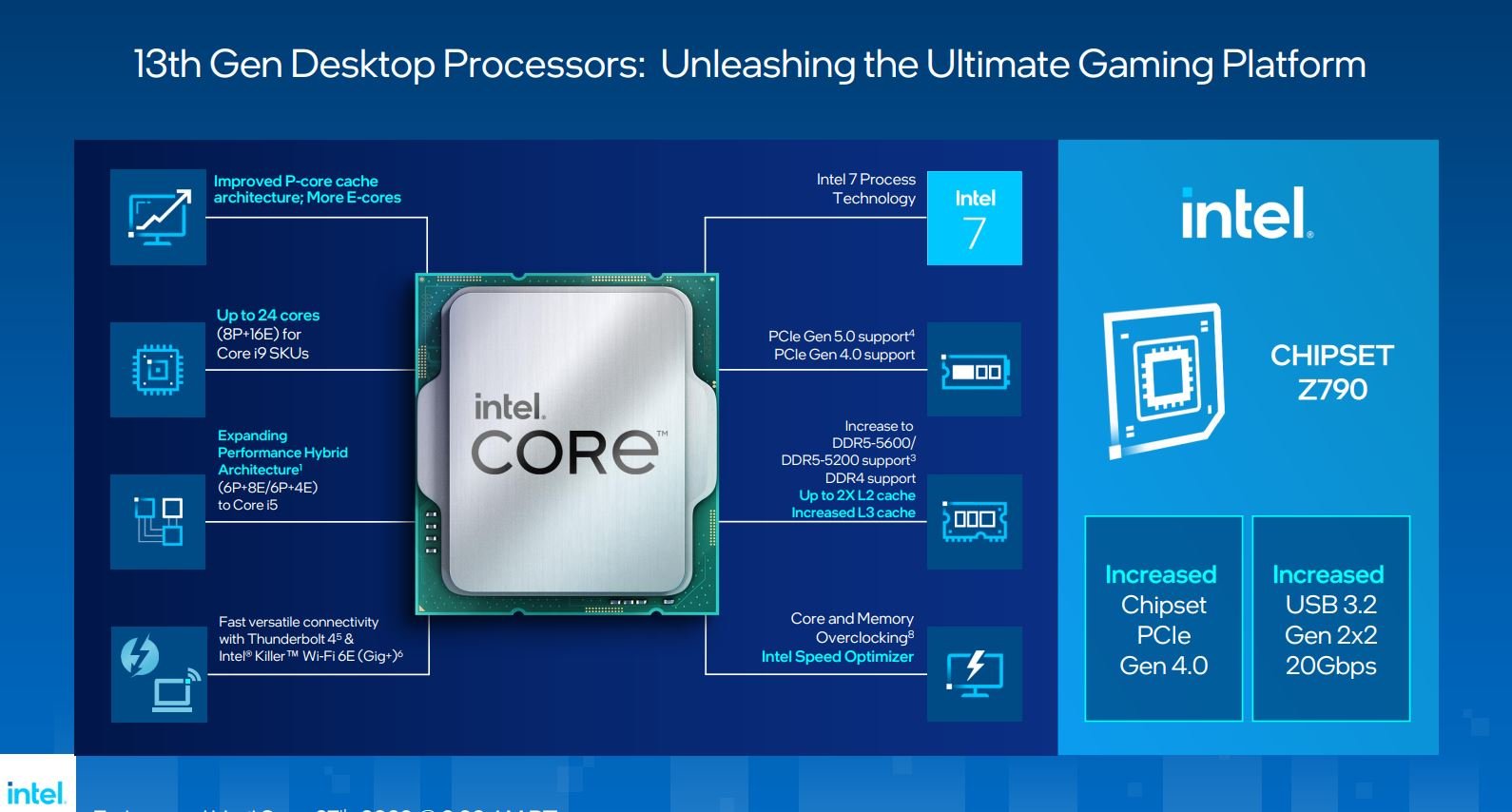
Looking at the wider introduction first, Intel is adding more E-cores for Core i5, Core i7 and Core i9 families, translating to greater processing power across the entire stack. On top of that, the hybrid memory controller is now specified for native operation at DDR5-5600 speeds, up from DDR5-4800 on 12th Gen Core.
Intel has already announced 700 Series chipsets to fully support 13th Gen Core processors. Flagship Z790, however, doesn’t differ much from today’s Z690, which will also support Raptor Lake processors through a BIOS update.
Moving with the times, chipset PCIe 3.0 lanes are reduced from 16 to 8, while 4.0 lanes conversely rise from 12 to 20, primarily to service high-speed expandability for peripherals hanging off the PCH. There’s a further USB 3.2 2×2 20Gbps port, as well, but that’s your lot.
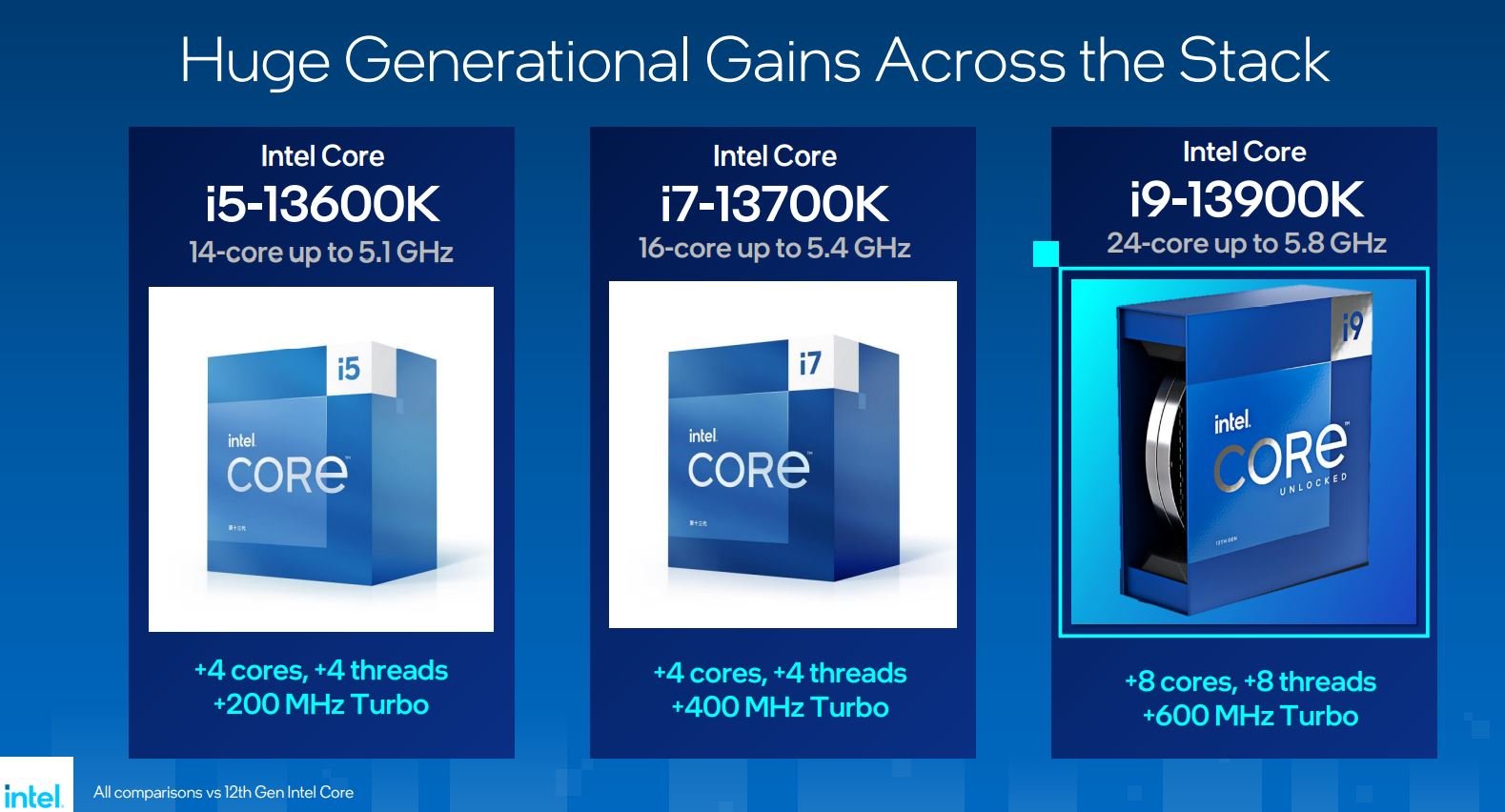
Fuelling Performance Through More Cache
Intel comments it’s been able to boost Raptor Lake frequencies by using an improved version of third-generation Intel 7 process. Like latest Ryzens, this shifts the voltage/frequency curve out by a reasonable amount.
13th Gen Core can run at the same speed as 12th Gen Core with 50mV less juice – leading to the appetising idea of heaps of performance at reduced TDPs – or offer an additional 200MHz at the same voltage. Cranking out more speed with an expanded TDP range is how the newest Core i9 scales up to 600MHz higher, which is a key weapon in its arsenal.
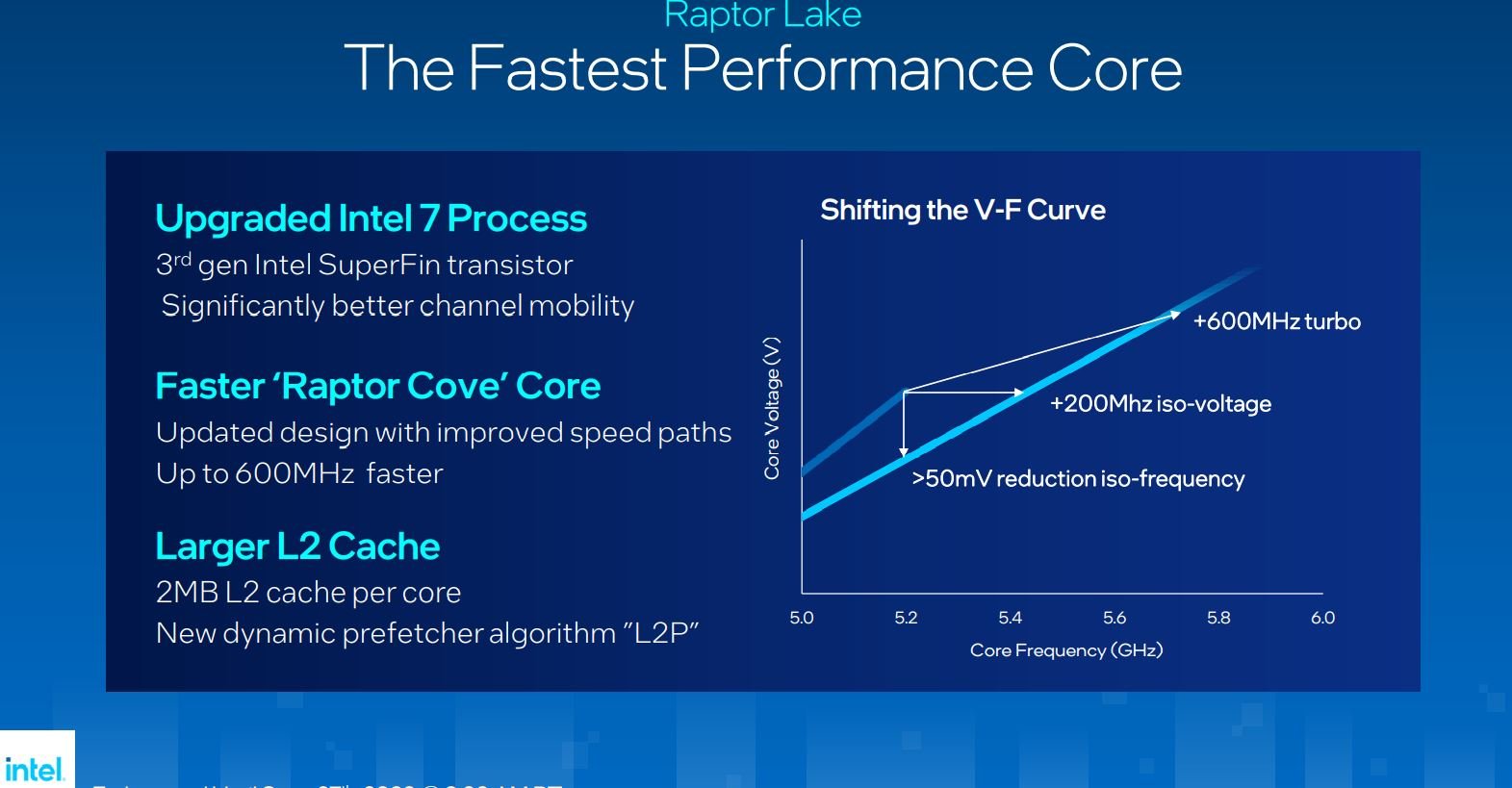
We know E-cores are more numerous this generation and Intel keeps to the tried-and-trusted Gracemont microarchitecture – the smaller cores are identical on Alder and Raptor Lake. That said, performance ought to be better as Intel doubles L2 cache from 2MB per four-core E-core cluster to 4MB. A small but important detail.
P-cores also benefit from more L2 cache. You may recall 12th Gen offered 1.25MB per core – 13th Gen ups this to 2MB. Put simply, an 8P+8E chip (16 cores, 24 threads) from the Alder Lake generation carries a total 14MB L2 (8×1.25 + 2×2) while Raptor Lake jumps to 24MB (8×2 + 2×4). More cache never hurts if latency is kept at around the same levels, and Intel also adds to L3 capacity for each family. Getting the feeling Intel is going Arnie-style gung-ho with nary a thought for ballooning transistor budgets?
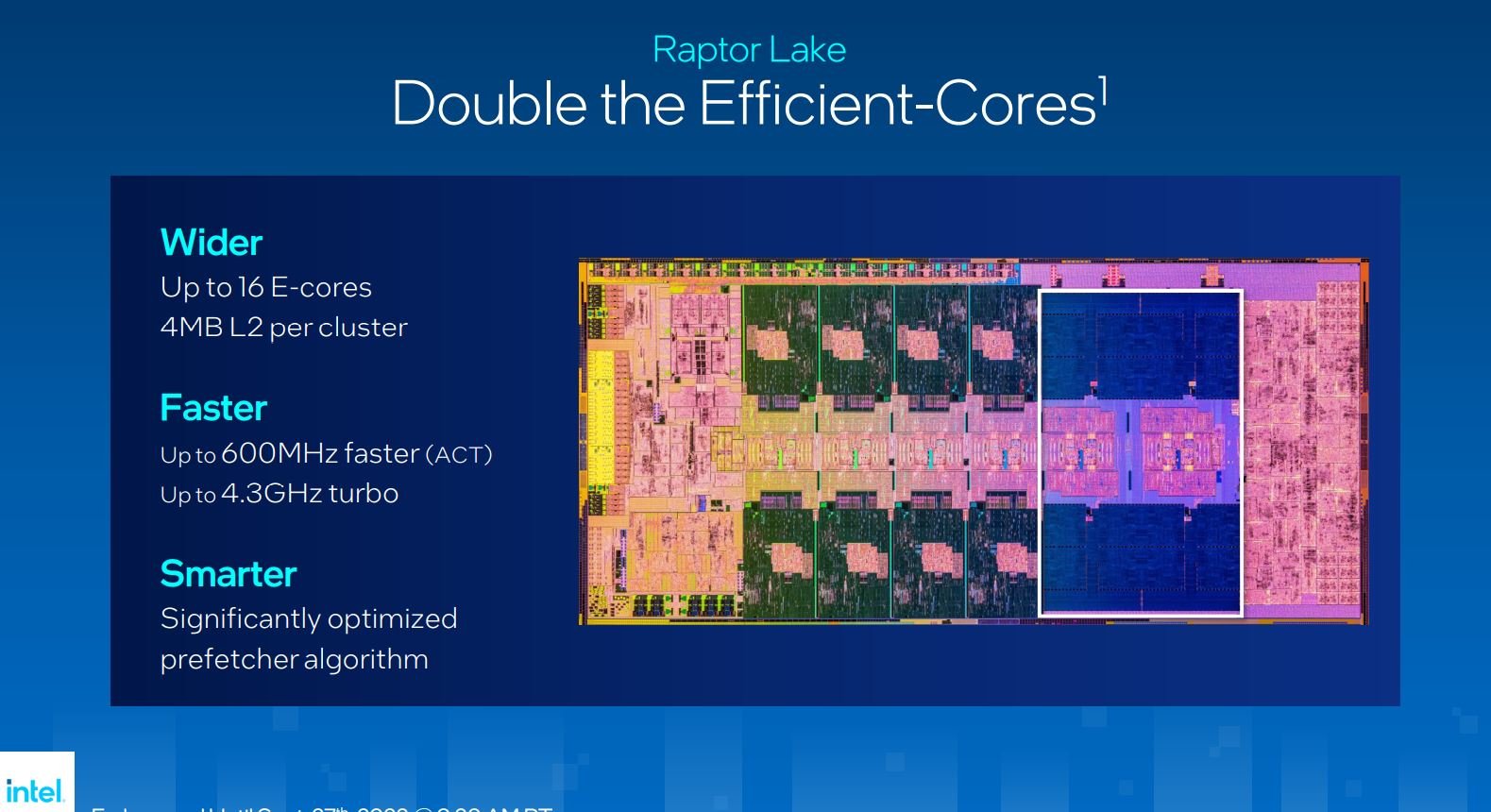
Last of the Monoliths
Intel’s forward-looking architecture strategy is to shift away from a monolithic die – where all constituent IPs are integrated into one piece of silicon – and favour disaggregated design instead. Rendering 13th Gen Core last of the client-side monoliths, Raptor Lake has the honour of being the last of a long time of high-performance desktop processors built in a particular fashion. Le Roi est mort, vive le Roi.
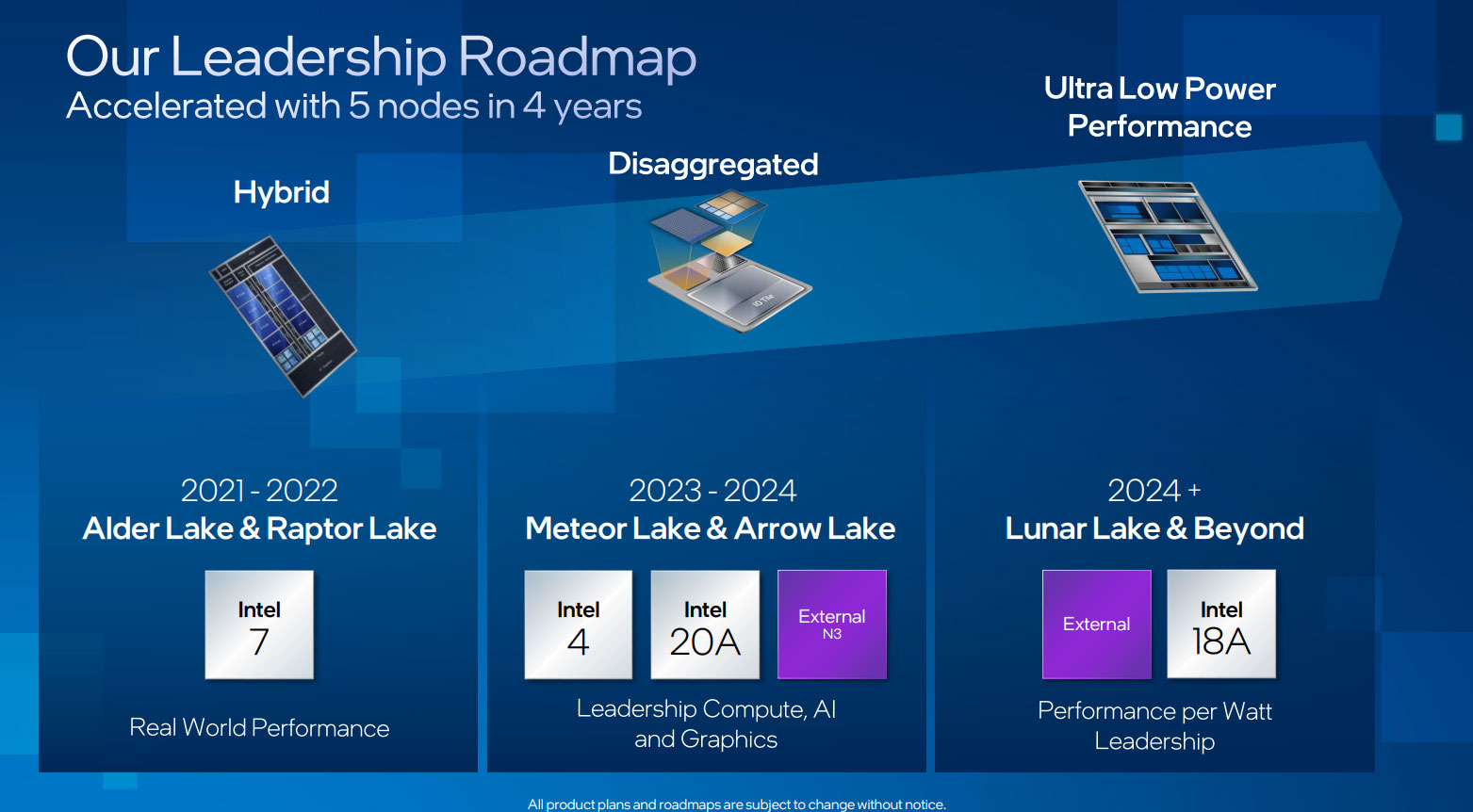
Raptor Cove Operates Differently To Golden Cove
But pull the curtain back and a few new additions come into view. Raptor Lake uses a significantly optimised prefetching algorithm. Speaking to Adi Yoaz, chief architect for P-cores, this is actually a feature baked into Alder Lake too. There’s a firmware-upgradeable power management microcontroller built into Alder Lake’s Golden Cove P-cores which runs on a per-core basis and offers fine-grained adjustments.
Intel’s fastest-ever client processor is armed and ready to wreak havoc.
For Raptor Cove P-cores, however, Intel is extending the reach of this microcontroller to adjust other aspects of the core aside from monitoring telemetry and frequencies. In hushed tones, Yoaz informed Club386 Intel can control the behaviour of the prefetching unit and whether L2 and L3 caches are inclusive or non-inclusive by introducing new algorithms through firmware updates. Knowing the microcontroller affects parameters every 200 microseconds, there’s plenty of on-the-fly optimisation taking place on Raptor Cove. What’s more, constant machine learnings update algorithms such that application performance improves over time.
In the future, using this microcontroller, “Intel will have more and more algorithms that will adapt and modify the machine to the actual application that’s being run,” continued Yoaz.
Given this is a firmware-led upgrade and the microcontroller technology already exists in Alder Lake, an interesting question is whether it can be backported to 12th Gen Core for improved performance. Intel chose not to answer this pressing question during our chat with Adi at a technical tour event in Israel a few weeks back. The enhanced prefetching and cache algorithms in Raptor Cove are marketing decisions first and foremost, to help differentiate from the direct predecessor which effectively uses the same core technology. Liberally applied in the server business, Intel is no stranger to expanded performance via firmware updates.
Rumours are abounding that processors below the Core i5-13600K(F) will use Alder Lake technology rather than Raptor Lake, with core-and-thread counts and frequency massaged to fit into the intended Core i5 and Core i3 segments. Time will tell.
Launch Models and AMD Comparison
| CPU | Cores | Threads | L2 | L3 | Turbo | Base TDP | Max TDP | MSRP |
|---|---|---|---|---|---|---|---|---|
| Core i9-13900K | 24 (8P+16E) | 32 | 32MB | 36MB | 5.8GHz | 125W | 253W | $589 |
| Core i9-12900K | 16 (8P+8E) | 24 | 14MB | 30MB | 5.2GHz | 125W | 241W | $589 |
| Core i7-13700K | 16 (8P+8E) | 24 | 24MB | 30MB | 5.4GHz | 125W | 253W | $409 |
| Core i7-12700K | 12 (8P+4E) | 24 | 12MB | 25MB | 4.9GHz | 125W | 190W | $409 |
| Core i5-13600K | 14 (6P+8E) | 20 | 20MB | 24MB | 5.1GHz | 125W | 181W | $319 |
| Core i5-12600K | 10 (6P+4E) | 16 | 9.5MB | 20MB | 4.9GHz | 125W | 150W | $289 |
Notice something interesting? Core i7-13700K uses exactly the same hybrid-core approach as Core i9-12900K, meaning eight Performance cores allied to eight Efficient. Nevertheless, today’s i7 head honcho is faster than the best of the Alder Lake generation because it uses a more refined architecture – Raptor Lake has more cache and better prefetching capability than Alder Lake – and marginally higher frequencies. In fact, even Core i9-12900KS, which is a limited-edition processor costing a whopping $739 at launch, doesn’t have the chops to compete with today’s i7. Progress, eh.
By arming 13th Gen Core with such innate firepower, Intel has effectively moved everything up at least a class. For example, Core i5 performs like a Core i7/i9, while Raptor Lake i7 is better than any previous Core i9.
| Core i7-13700K | AMD Ryzen 9 7900X | AMD Ryzen 7 7700X | |
| Cores/threads | 16/24 | 12/24 | 8/16 |
| Peak frequency | 5.4GHz | 5.6GHz | 5.4GHz |
| L2+L3 cache | 54MB | 76MB | 40MB |
| Max TDP/PPT | 253W | 230W | 142W |
| Recommended price | $409 | $549 | $399 |
And this combination of class upgrades whilst keeping pricing competitive makes 13th Gen Core particularly appealing to the enthusiast. Set against price-comparable processors from AMD’s recent Ryzen 7000 Series indicates the Core i7-13700K has enough oomph to easily deal with Ryzen 7 7700X and land heavy blows on the dearer Ryzen 9 7900X.
Letting the processor off the leash, Intel installs a 253W TDP, which is the same as range-heading Core i9-13900K. As no cooler is provided in the box, be sure to budget for a substantial offering; this chip is thirsty.
Intel Core i7-13700K
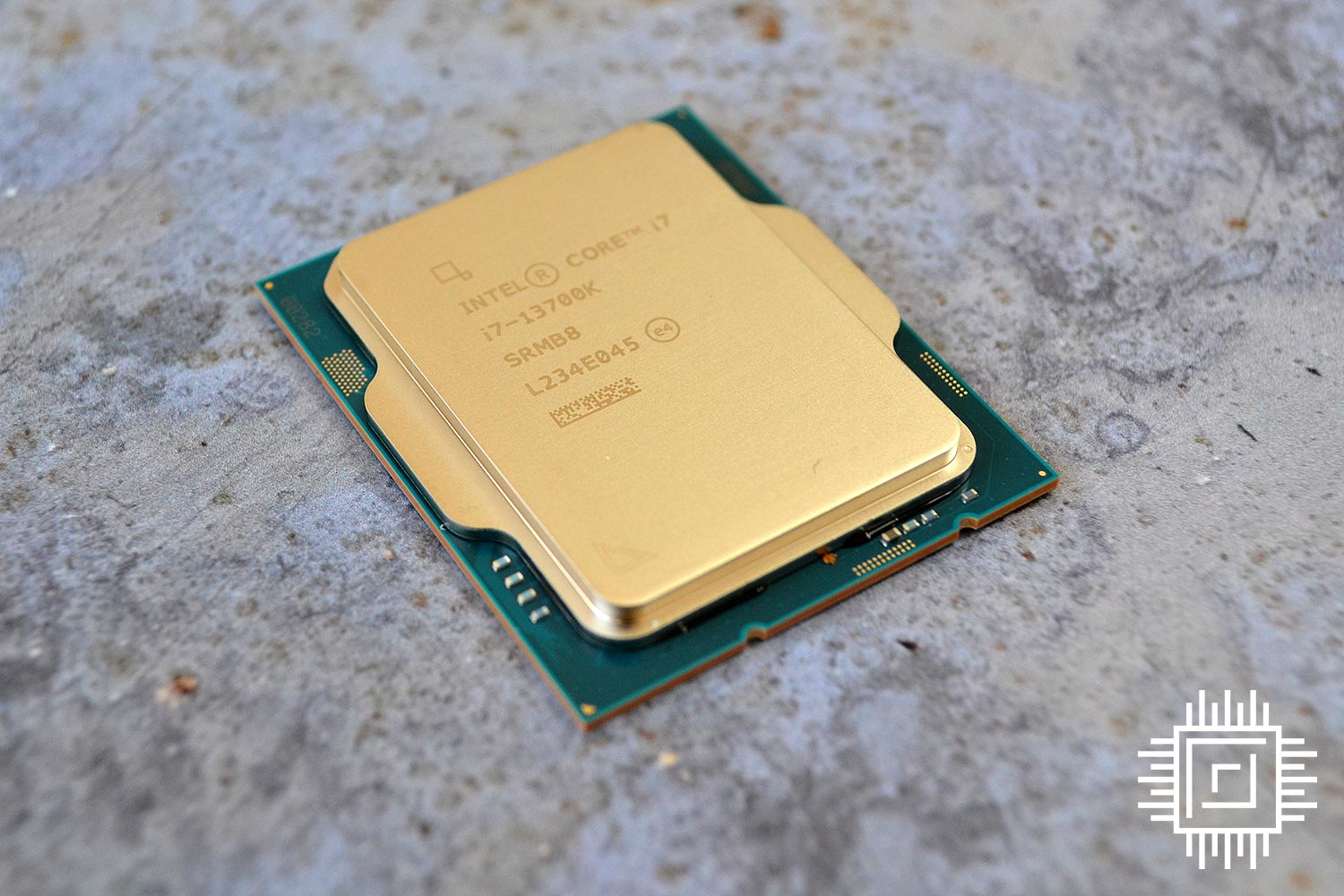
You’ve seen many like me before, haven’t you? The LGA1700 form factor was introduced with Alder Lake processors a smidgeon over a year ago and has plenty going for it. Motherboards released for the initial tranche of 12th Gen chips are fine homes for 13th Gen processors – they share the same socket, after all – so enthusiasts have the choice between 600- and 700-Series boards.
If it was our money on the line, we’d look towards a lower-end Z690 or Z790, but if you’re not concerned with heavy overclocking and believe the baked-in technology offers close to maximal performance, a $150 B660 is no bad choice.
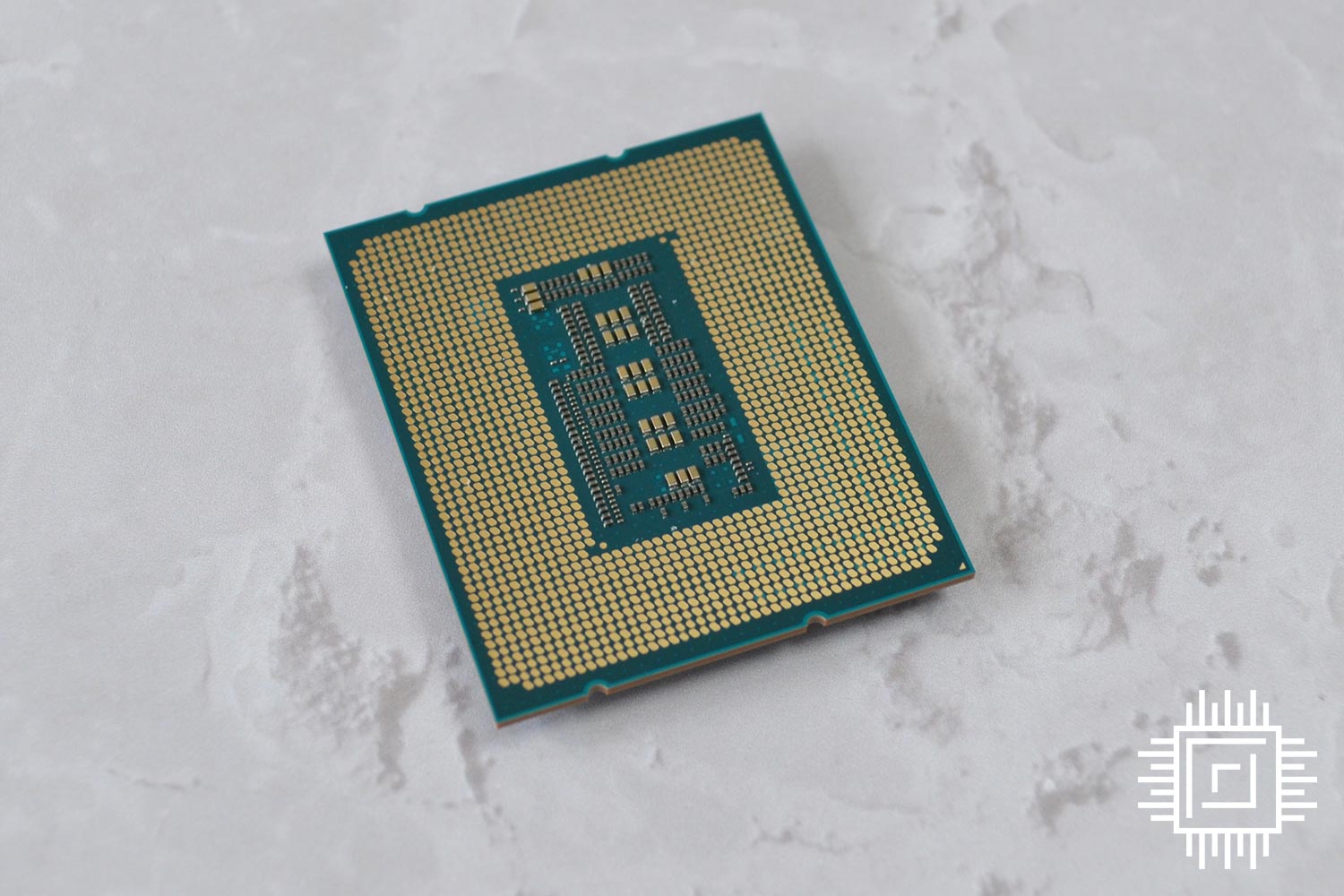
Core i7-13700K ships with basic integrated graphics known as UHD 770. Useful for video outputs in systems where a discrete card is not available, gamers can save a bit of dosh by opting for the Core i7-13700KF. Exactly the same as this chip other than having no built-in graphics, there’s a $25 saving based on recommended retail pricing.
Right-o, let the suspense now abate as we roll on to the all-important benchmarks.
Performance
Tests are carried out on Core i5-13700K on top of an Asus Maximus ROG Z790 Hero motherboard, 32GB (2x16GB) of G.Skill Trident Z5 Neo EXPO CL30 memory operating at official specifications of DDR5-5600 (CL30). The supporting cast, also common between all processors, consists of an Nvidia GeForce RTX 3080 FE graphics card, Seagate FireCuda 530 2TB SSD, and Noctua NH-D15 cooling. The ensemble is powered by a be quiet! Dark Power 13 1,000W PSU. The review chip is run at Intel-mandated settings of 253W maximum power.
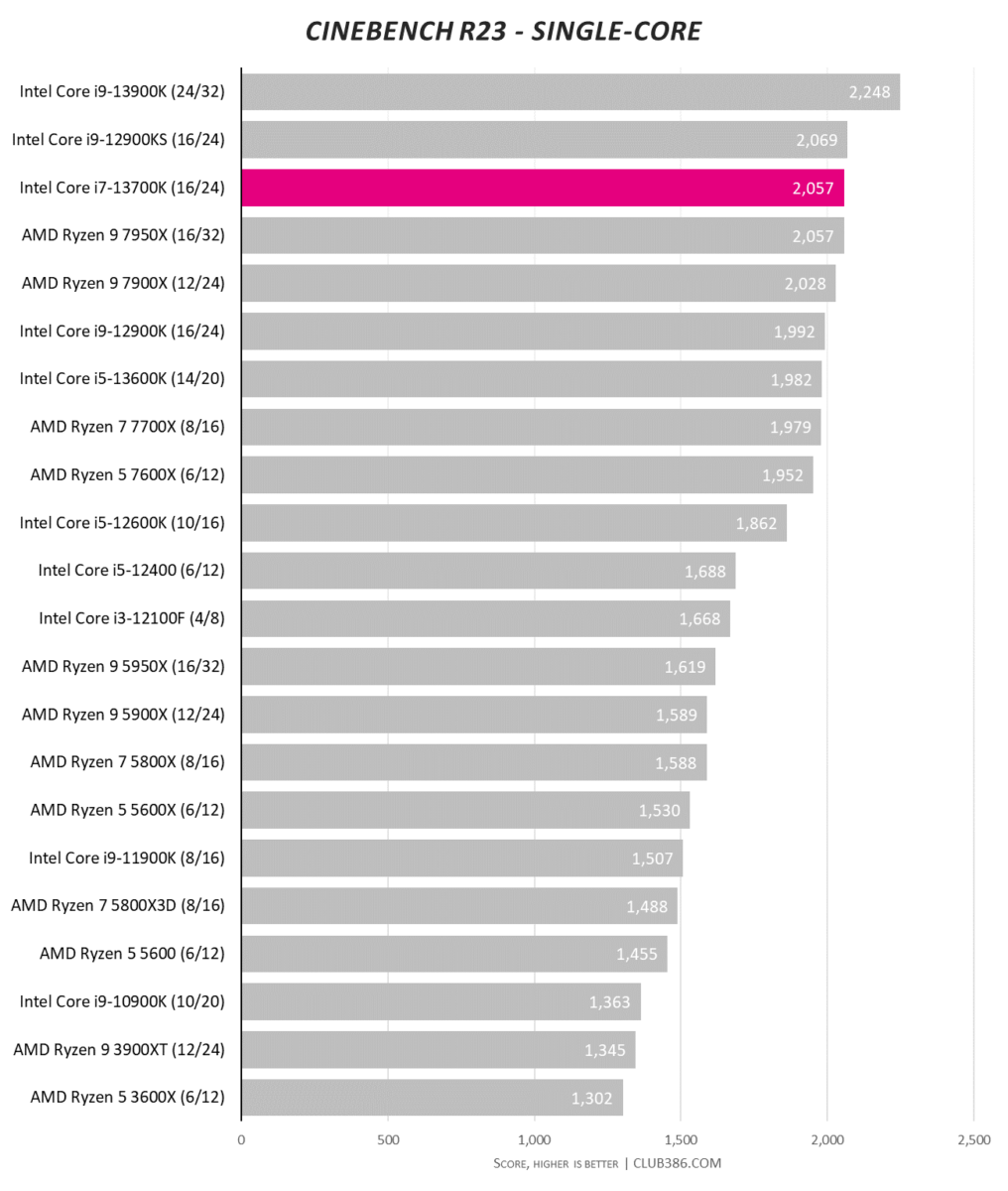
Having Raptor Lake technology and a 5.4GHz boost speed bodes well for both single- and multi-core applications. Any score over 2,000 is considered impressive, and Core i7-13700K manages to slot into third place. A fine start.
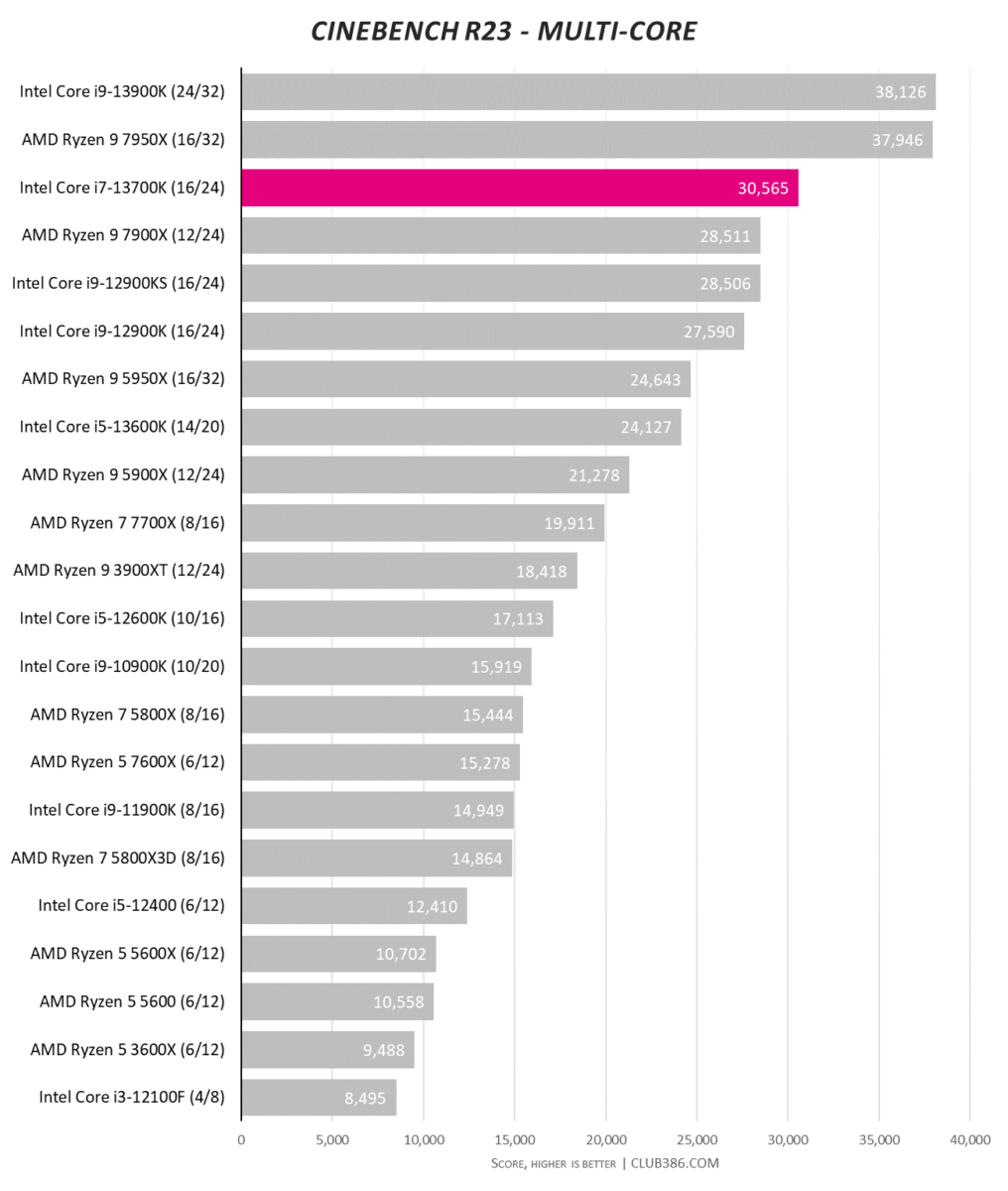
Based on the same 16-core, 24-thread design as the best of Alder Lake, it’s no surprise to see the the latest Core i7 champ outdistance even the 12900KS. Smashing through the 30,000-mark barrier, only 13900K and AMD’s top-bin Ryzen 9 7950X are quicker.
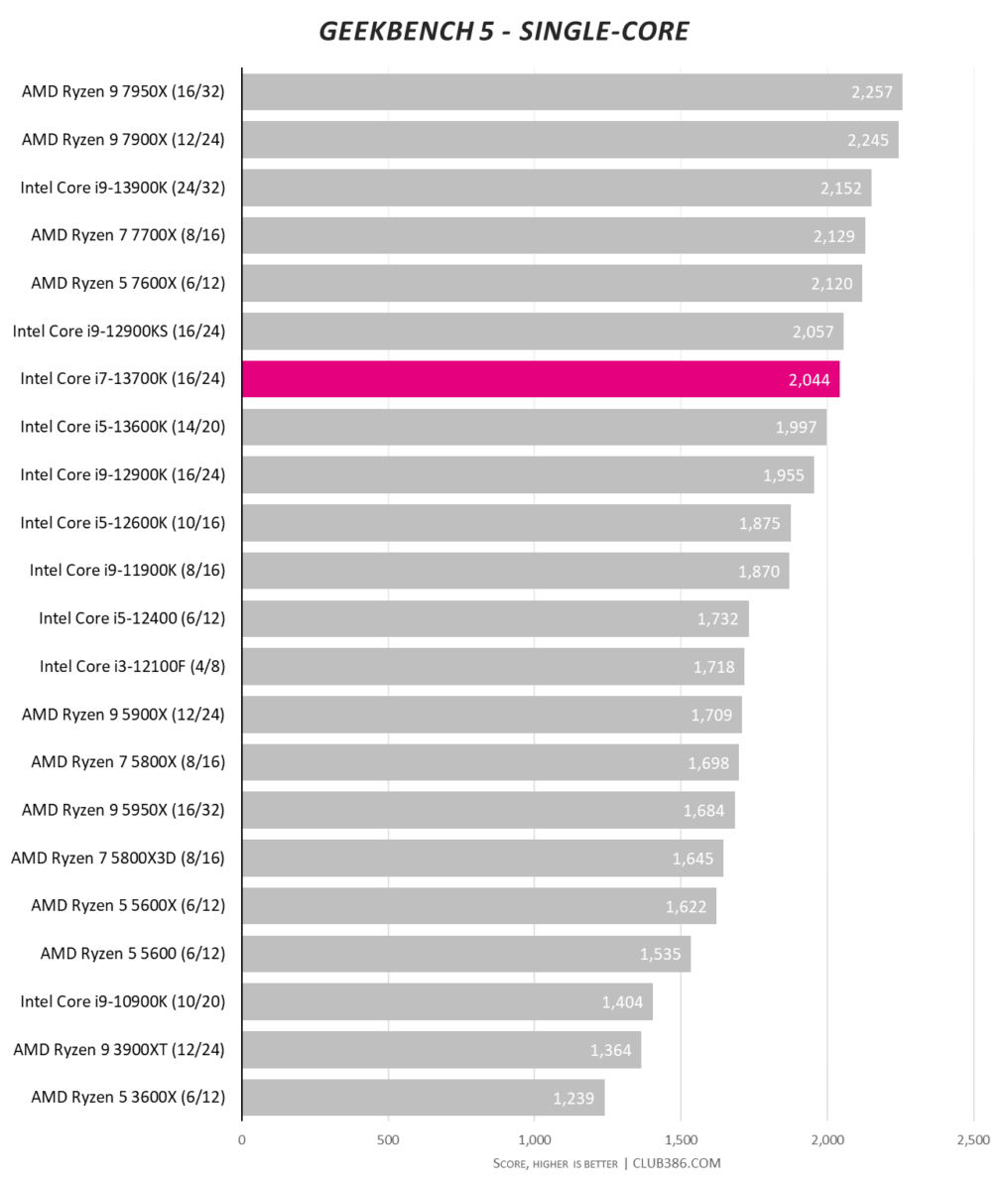
Rival AMD puts up a more robust showing in single-thread Geekbench 5. Nevertheless, every 12th Gen Core is distanced.
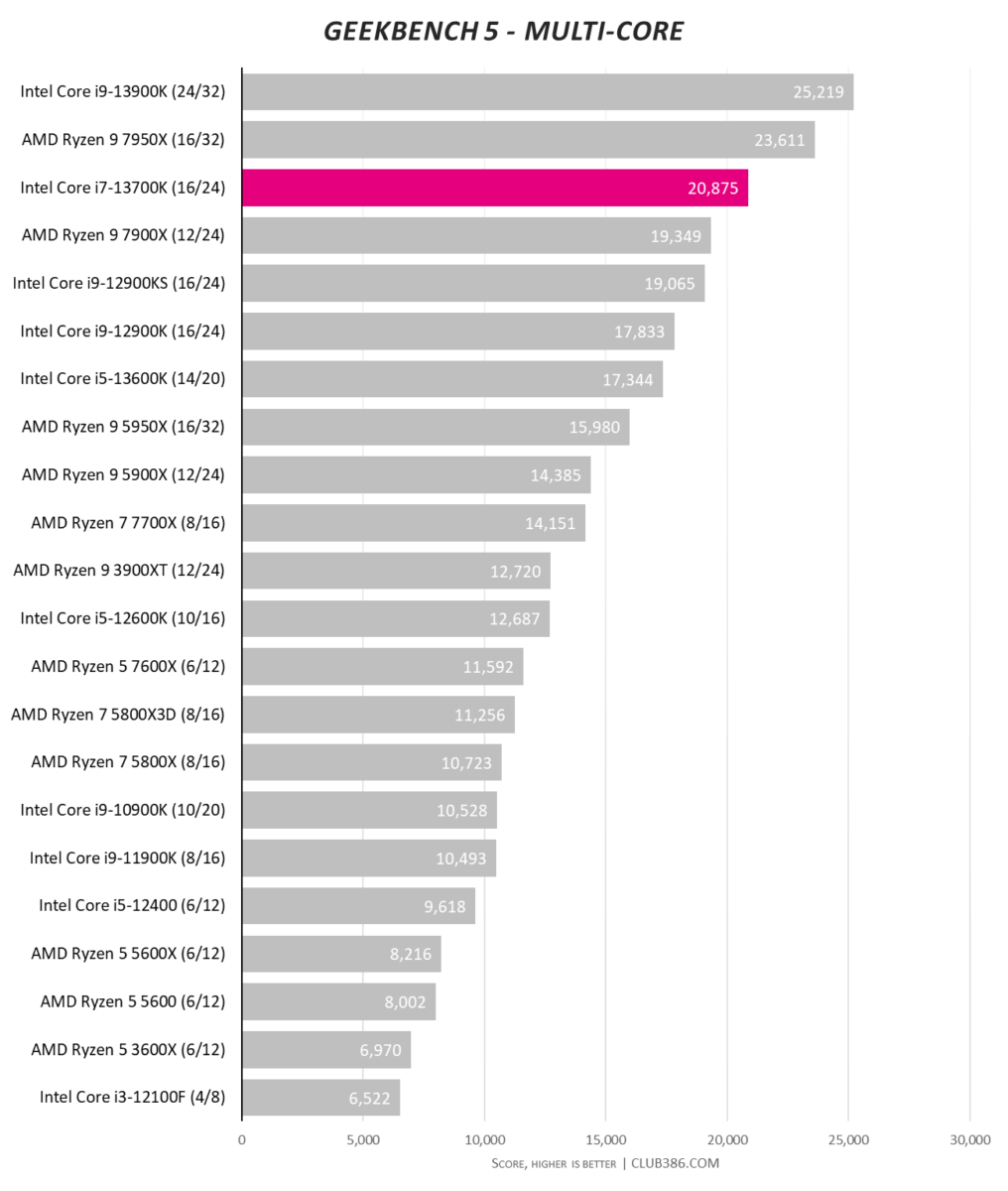
Beating out a Ryzen 9 7900X is no easy task, yet here we are.
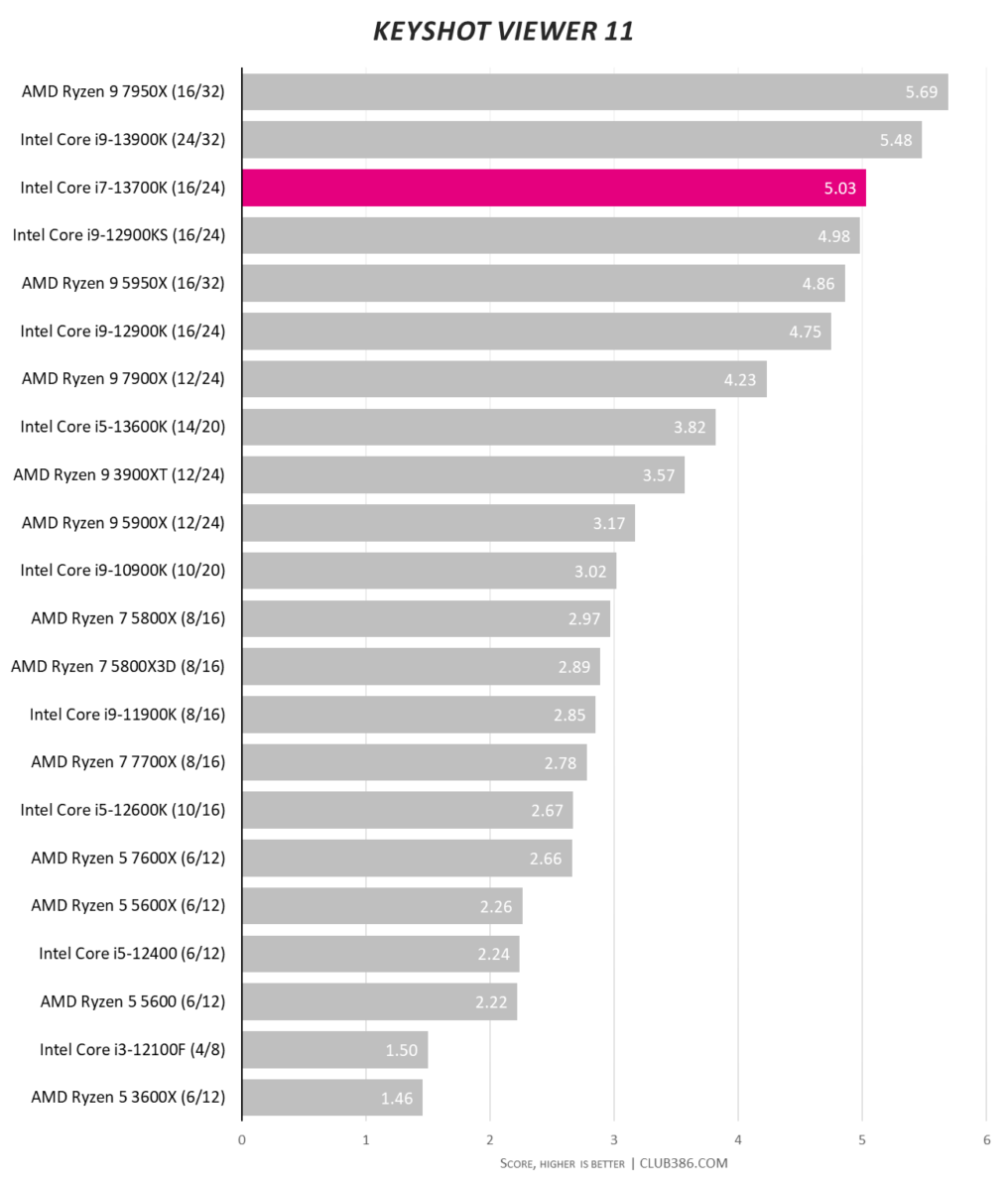
A Core i7 of the 13th Generation giving all Ryzen 5000 Series and 12th Gen Core processors a beating. Says it all.
| Core i7-13700K | AMD Ryzen 9 7900X | AMD Ryzen 7 7700X | |
|---|---|---|---|
| 7-zip 19.00 (HIB) | 157,712 MIPS | 170,613 MIPS | 119,843 MIPS |
| Blender 3.3.0 (HIB) | 454.8 samples | 462.2 samples | 311.4 samples |
| V-Ray 5.0.20 (HIB) | 21,430 samples | 22,003 samples | 15,100 samples |
| y-cruncher 9513 (LIB) | 148.1 seconds | 138.5 seconds | 167.8 seconds |
Knowing many readers look toward these mainstream processors as everyday workhorses, we’ve benchmarked additional multi-core applications with the three main $399-$549 protagonists. The most relevant comparison for the $409 Core i7-13700K is the $399 AMD Ryzen 7 7700X.
It’s not much of a competition, frankly, as Core i7-13700K is almost 50 per cent faster in some instances. It takes the vastly dearer Ryzen 9 7900X to bring performance parity.
Intel has gone super-aggressive with 13th Gen Core desktop pricing and performance, and it shows.
Memory
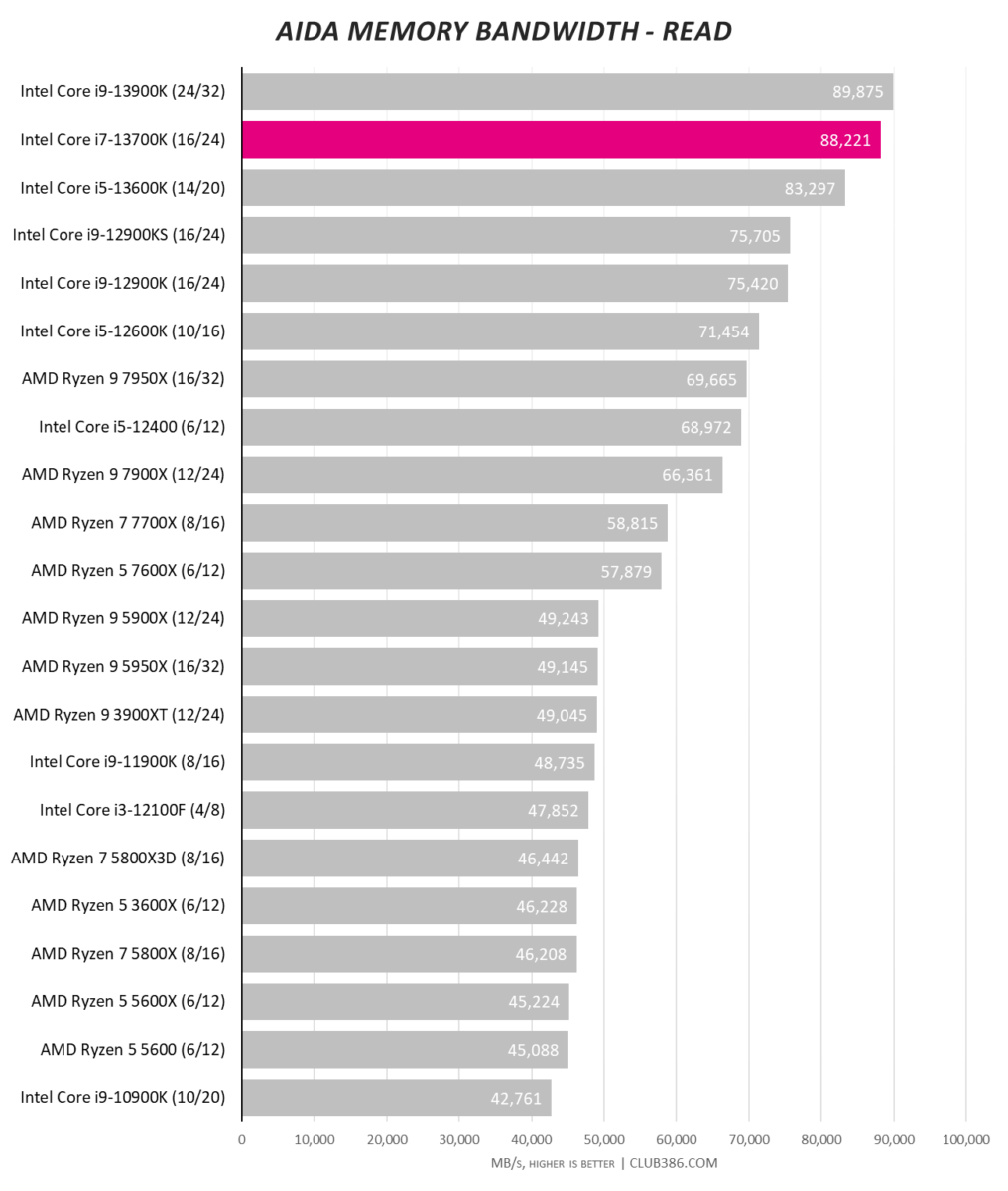
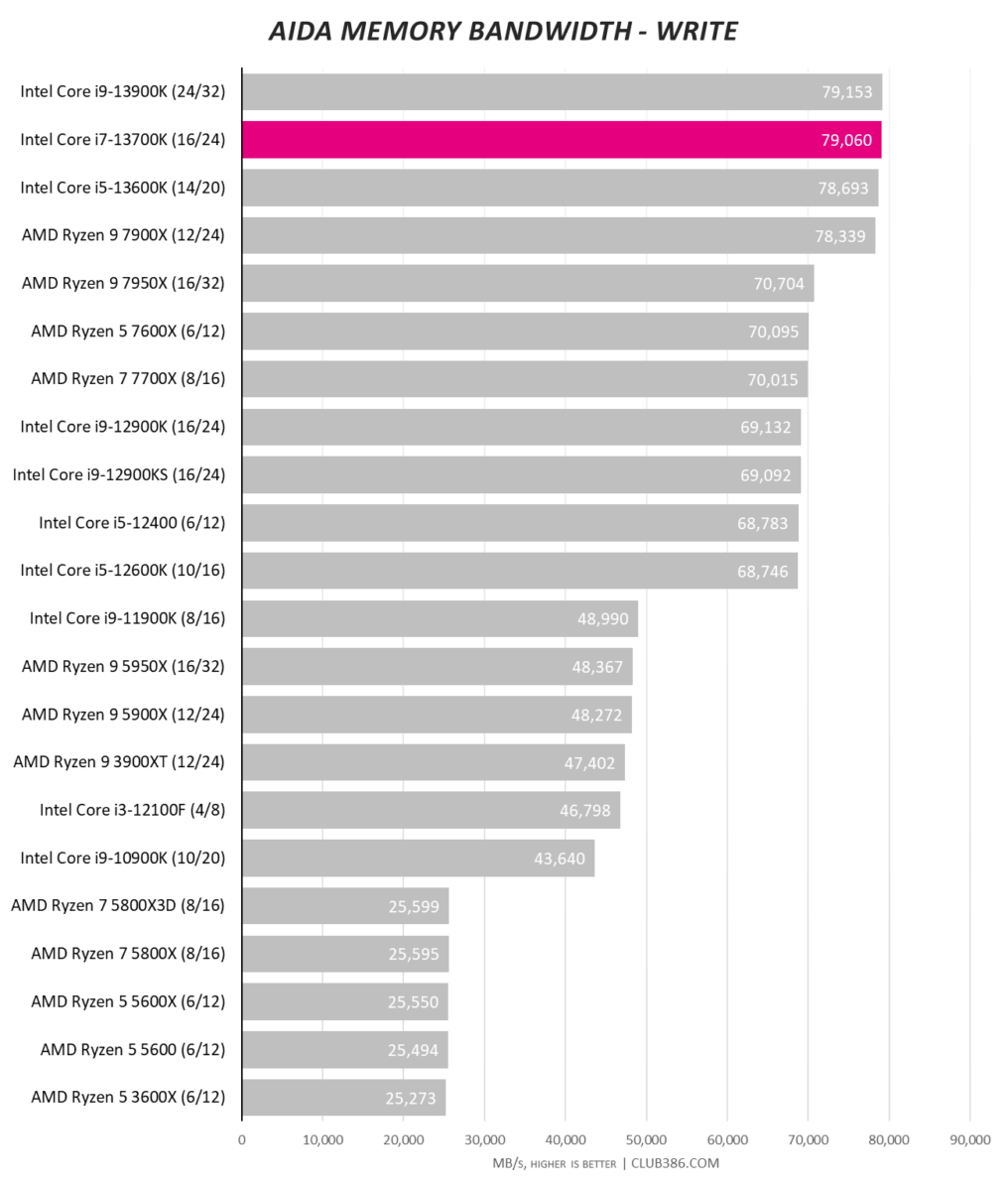
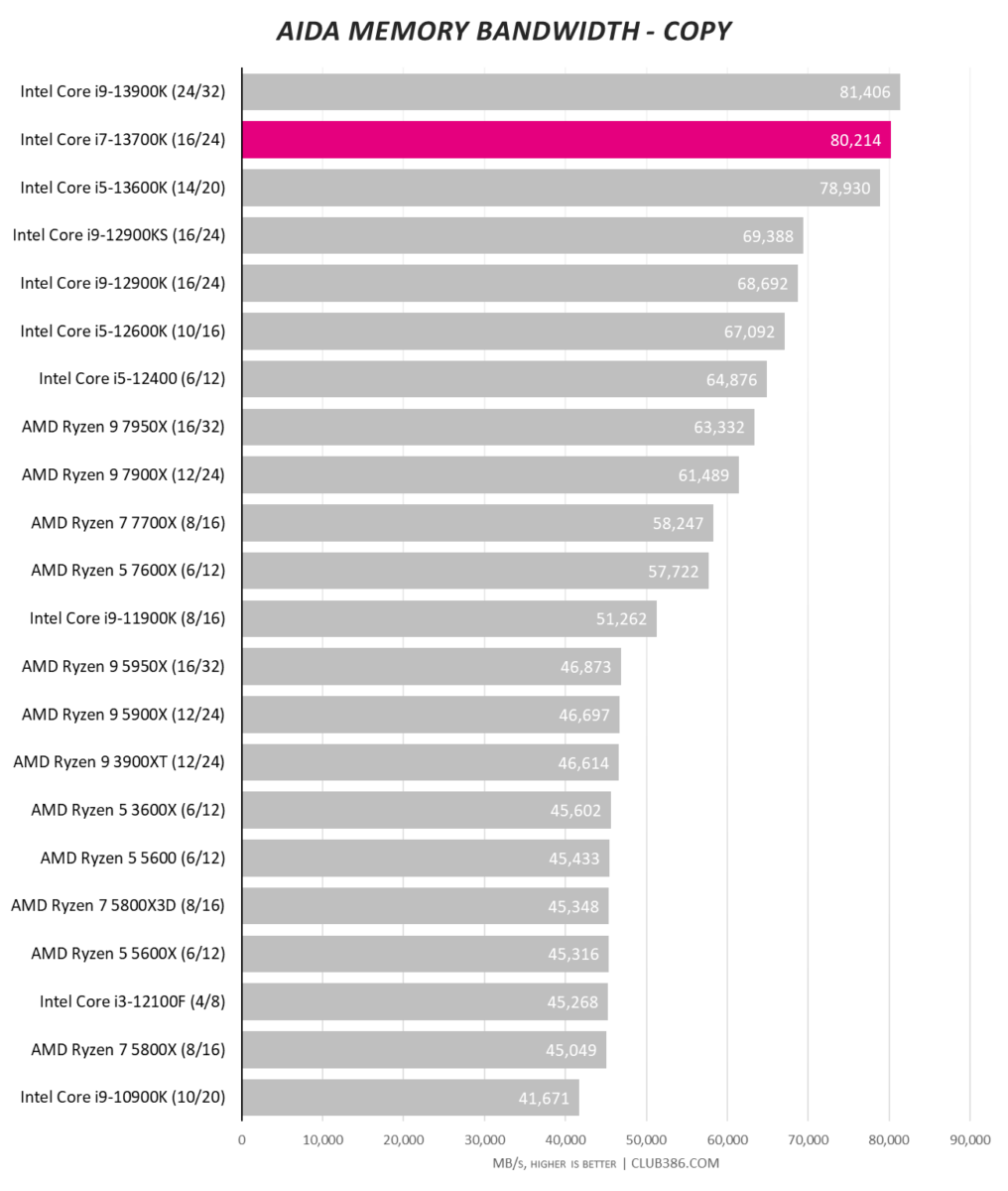
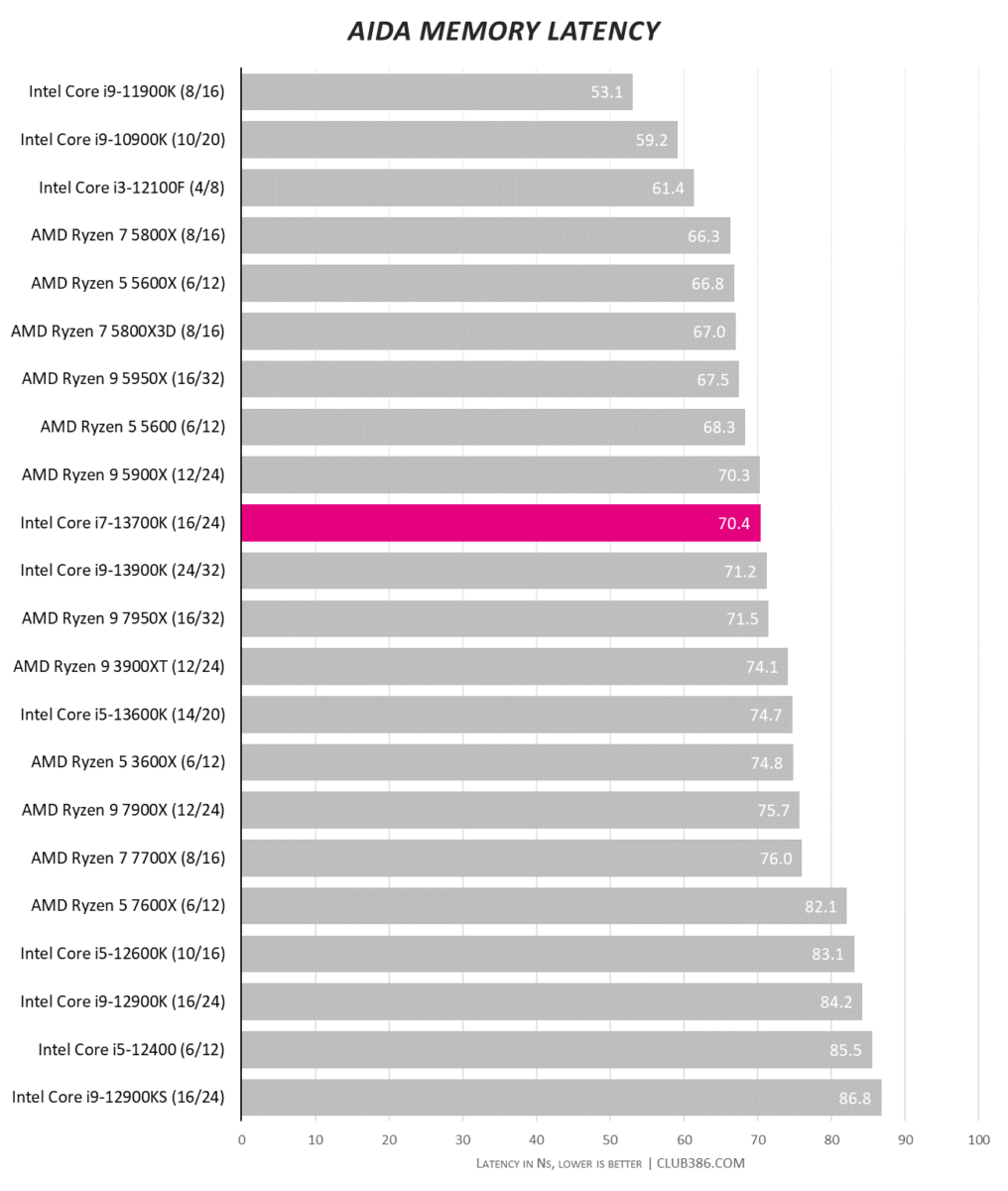
Using the same DDR5-5600 CL30 G.Skill memory on both Core i9-13900K and Core i7-13700K, we see, as expected, near-identical results. Intel continues to get more out of its memory controller than AMD.
System and Gaming
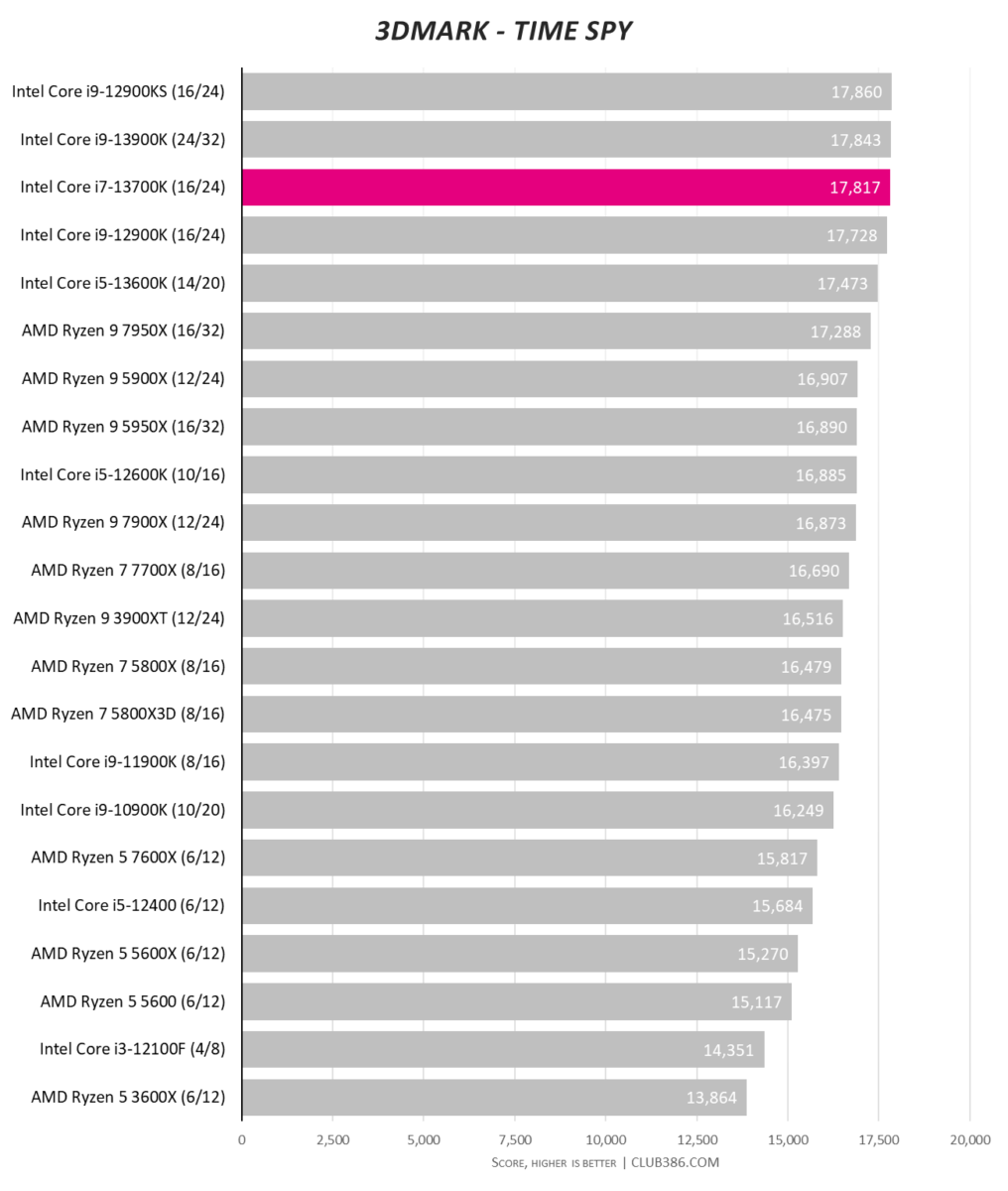
High-frequency Raptor Lake chip? Check. Great gaming performance? Check.
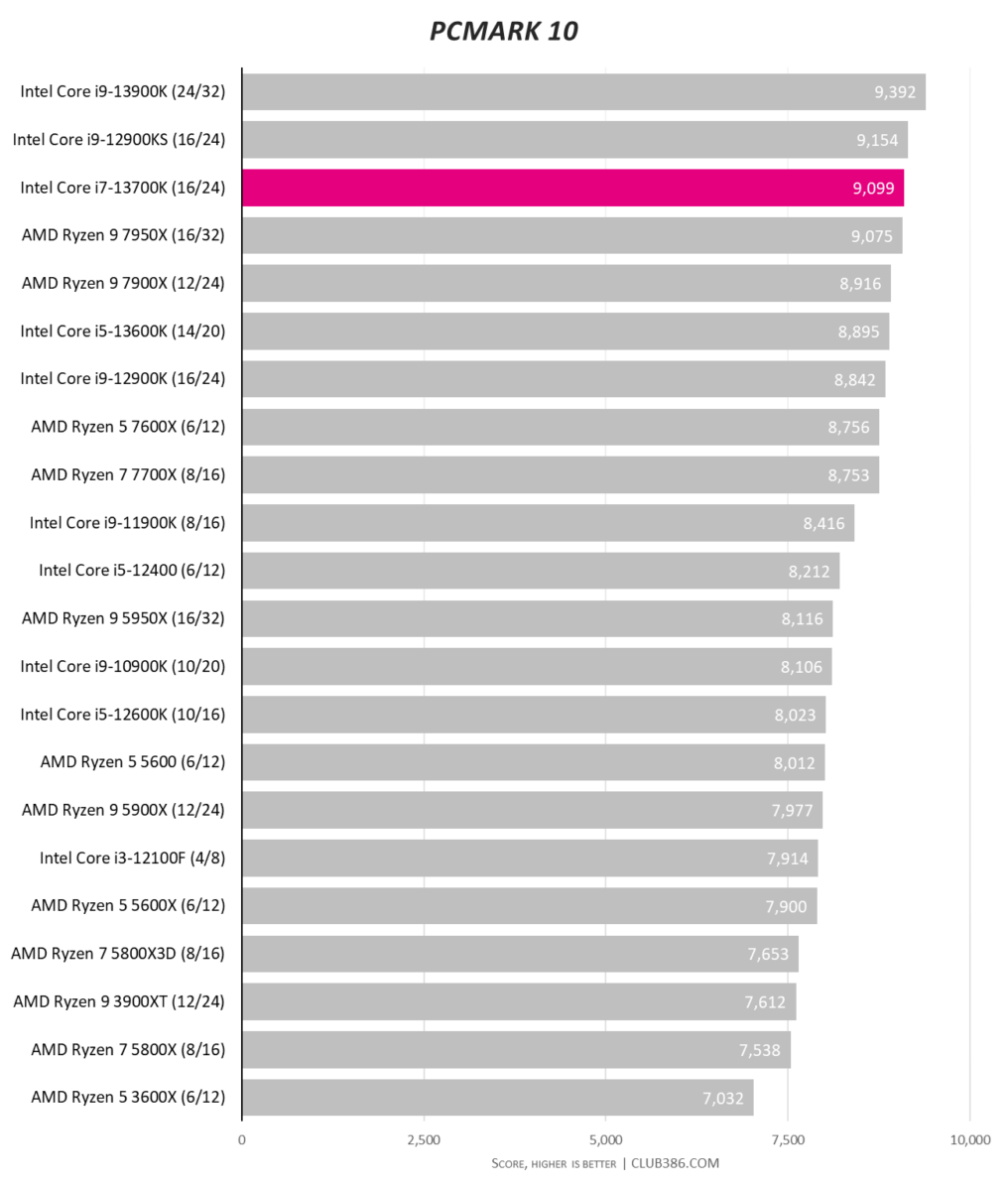
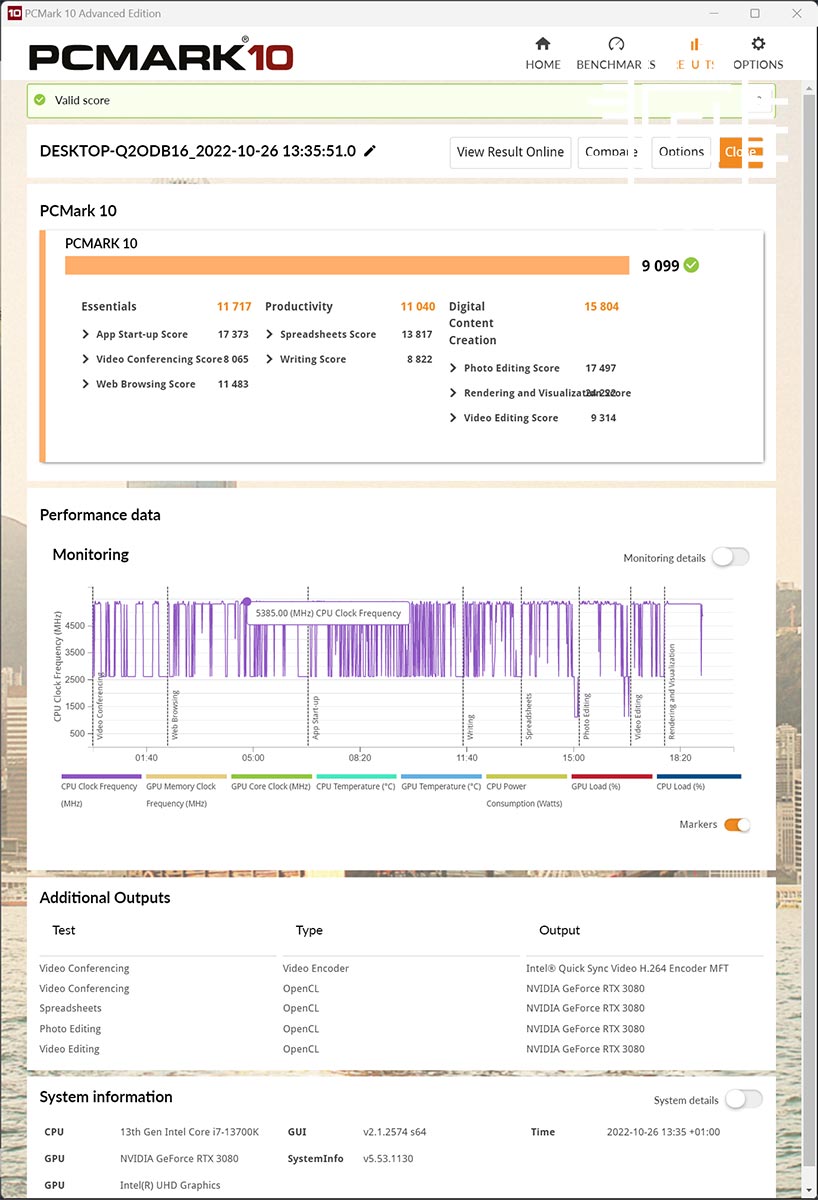
Jumping up to the prescribed 5.4GHz on a regular basis, Core i7-13700K is only one of four processors to breach the 9,000-mark barrier. Get the feeling this is a powerhouse of a chip?
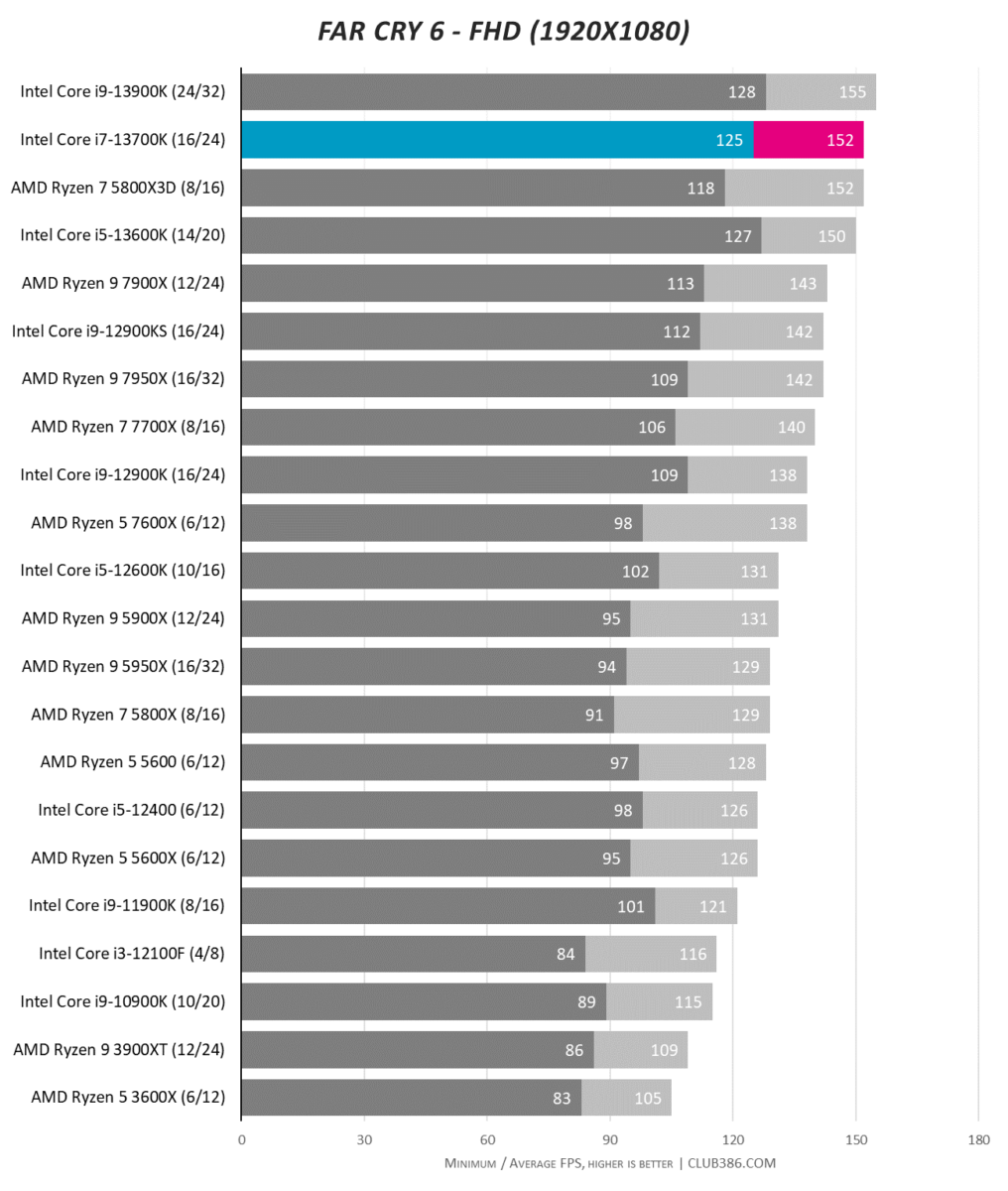
Knowing range-topping Core i9-13900K is the best CPU for gaming bodes well for our review chip. The proof of the Raptor Lake pudding is exemplary numbers in the first test.
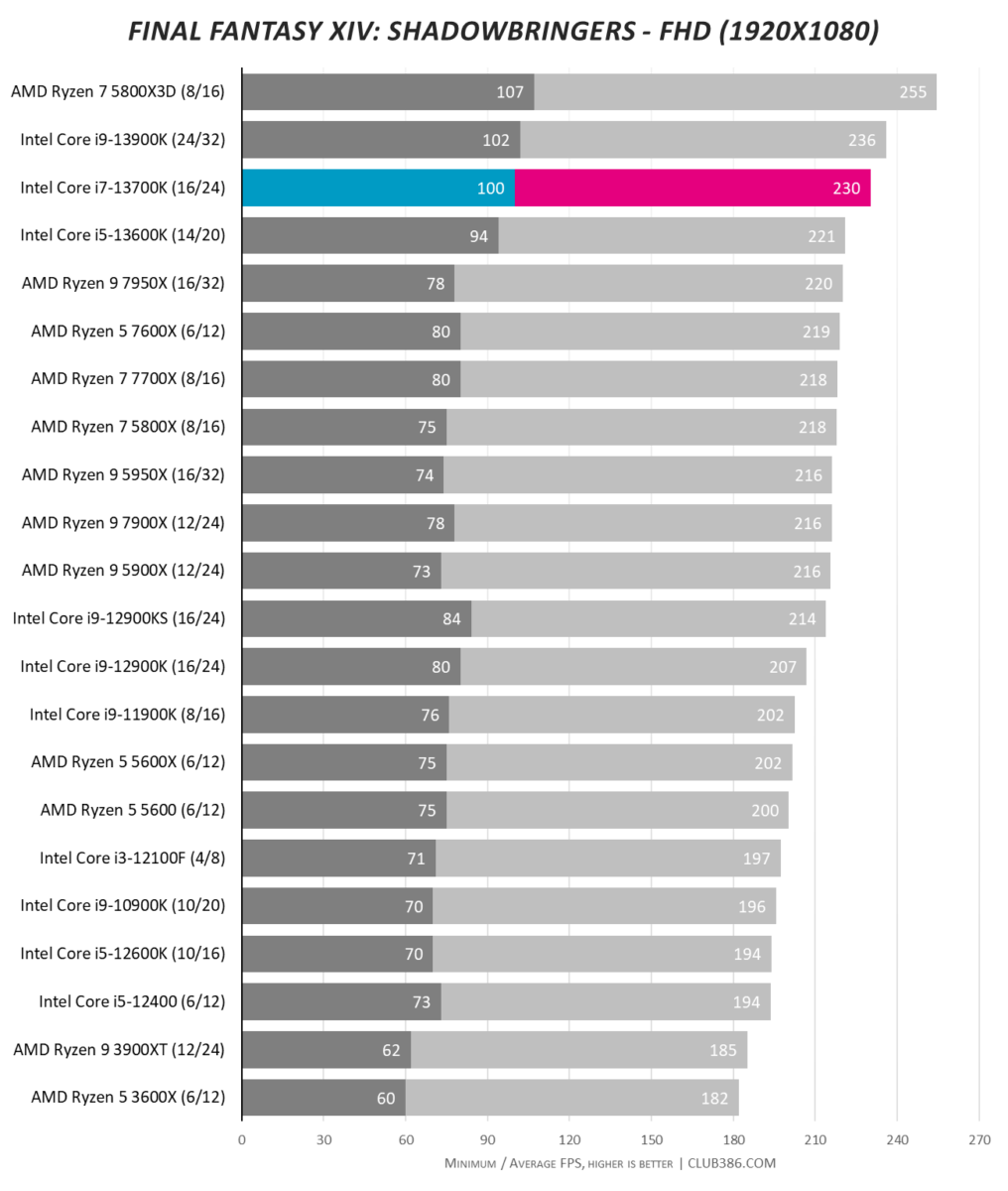
It’s understandable the Core i7-13700K benchmarks in third place. Significantly faster than any 12th Gen processor mainly through more on-chip cache, this is looking more and more like $400 well spent.
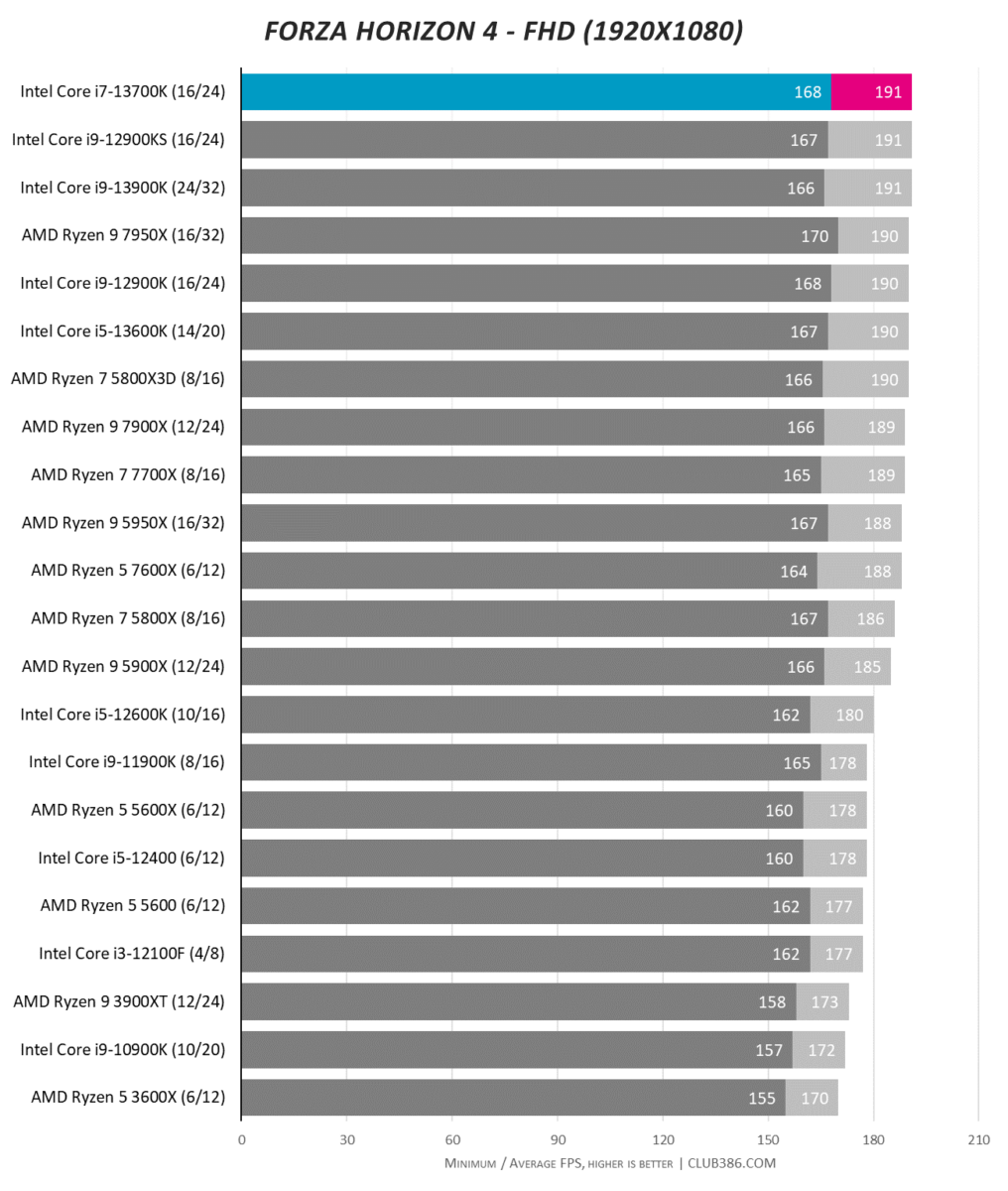
Top spot never hurts.
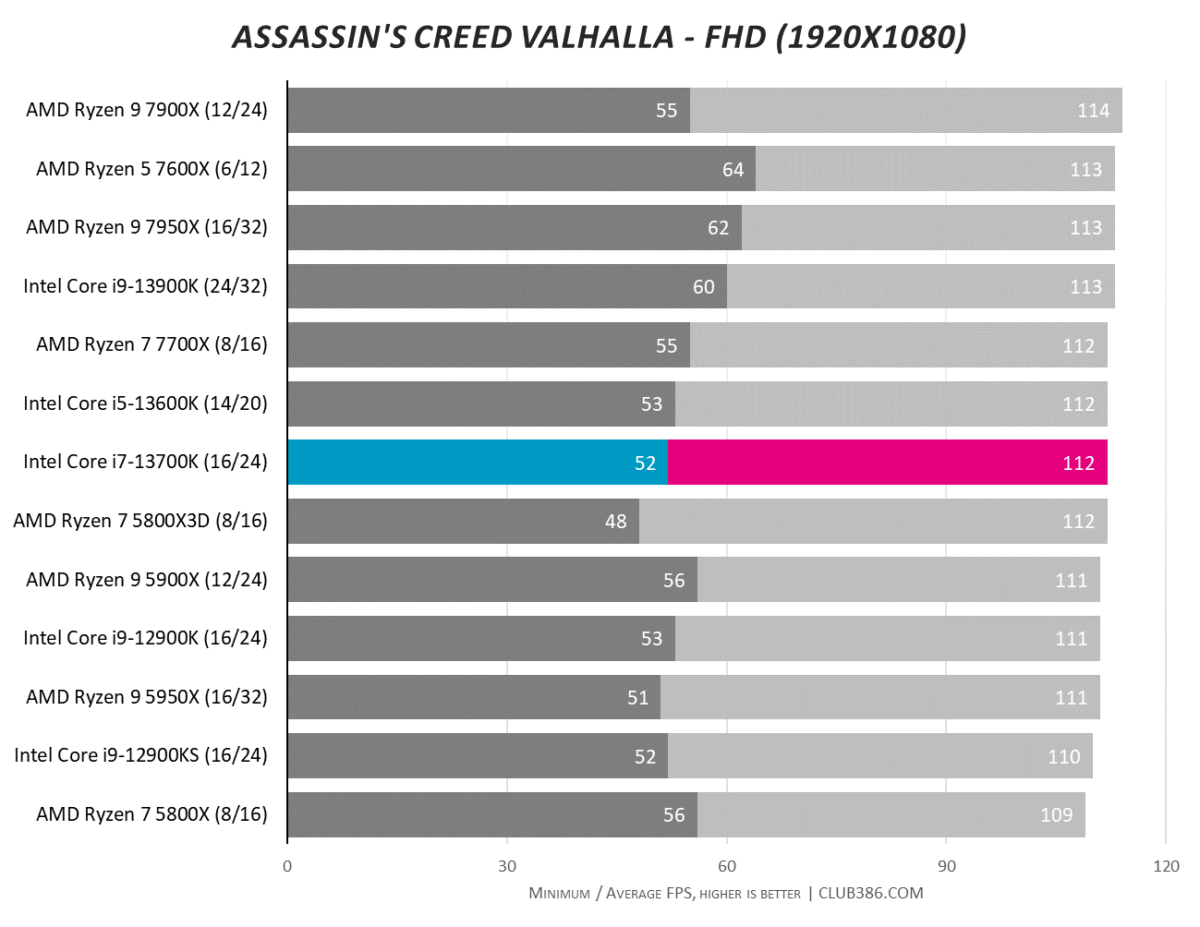
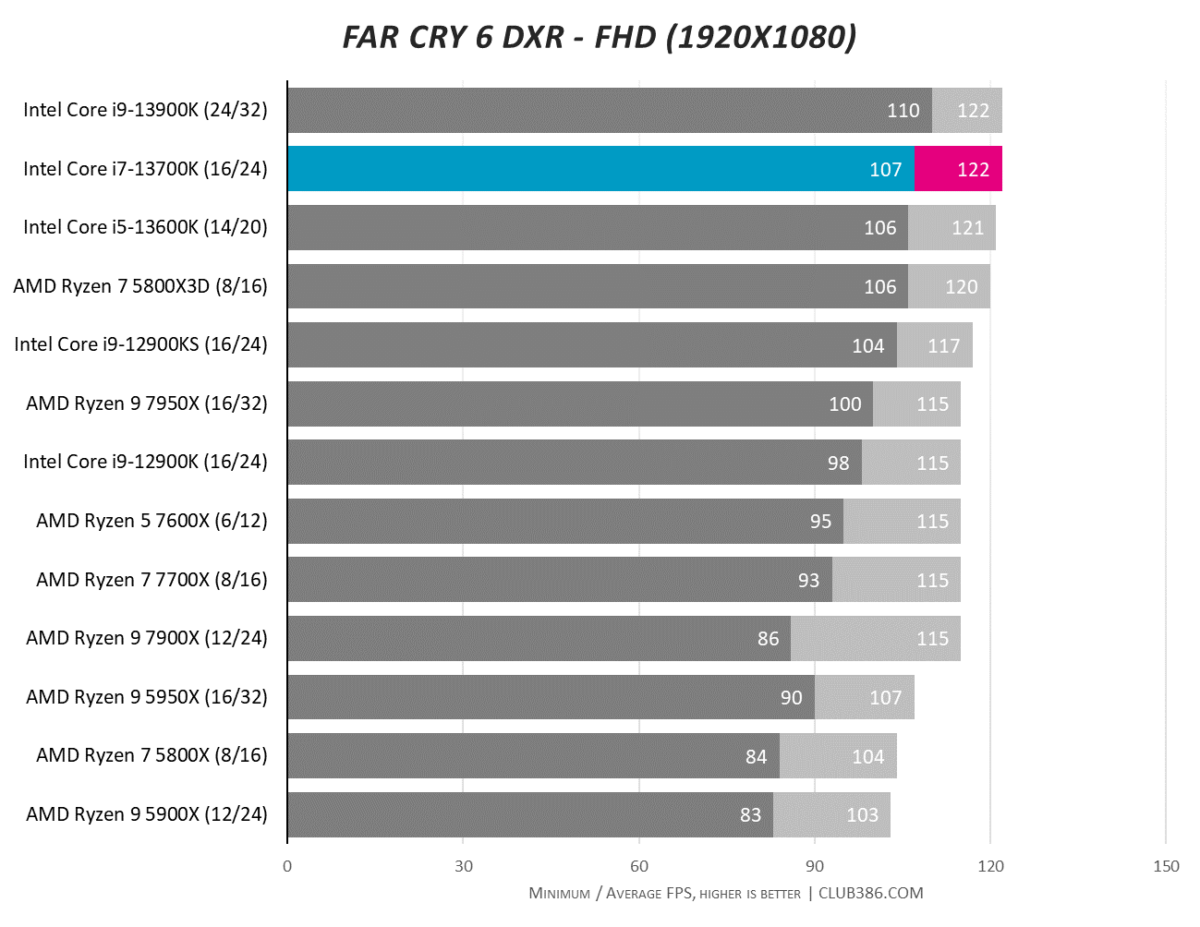
Running with ray tracing this time around, Raptor Lake processors take the first three spots. Only the cache-enriched Ryzen 7 5800X3D stands in the way.
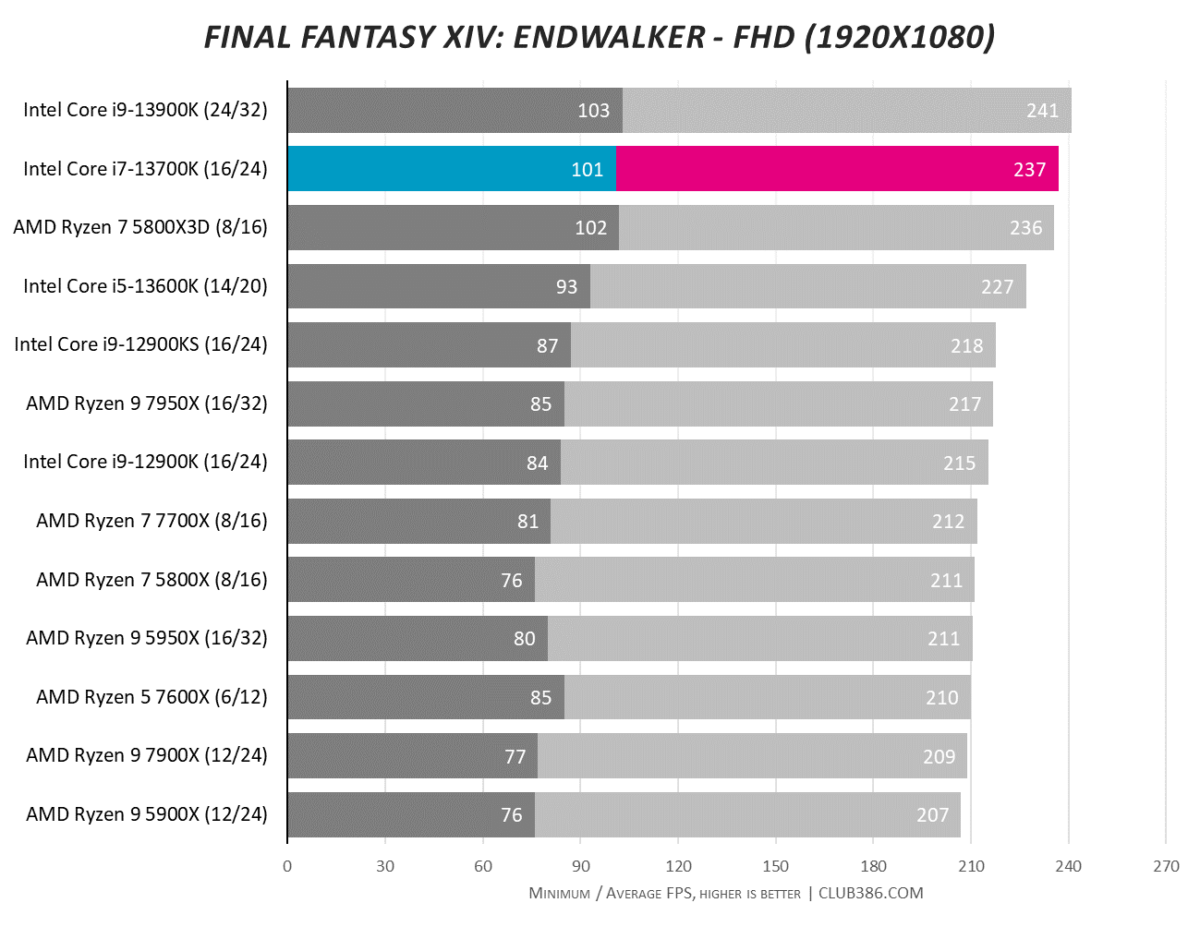
Way faster than the $739 Core i9-12900KS. Think about that.
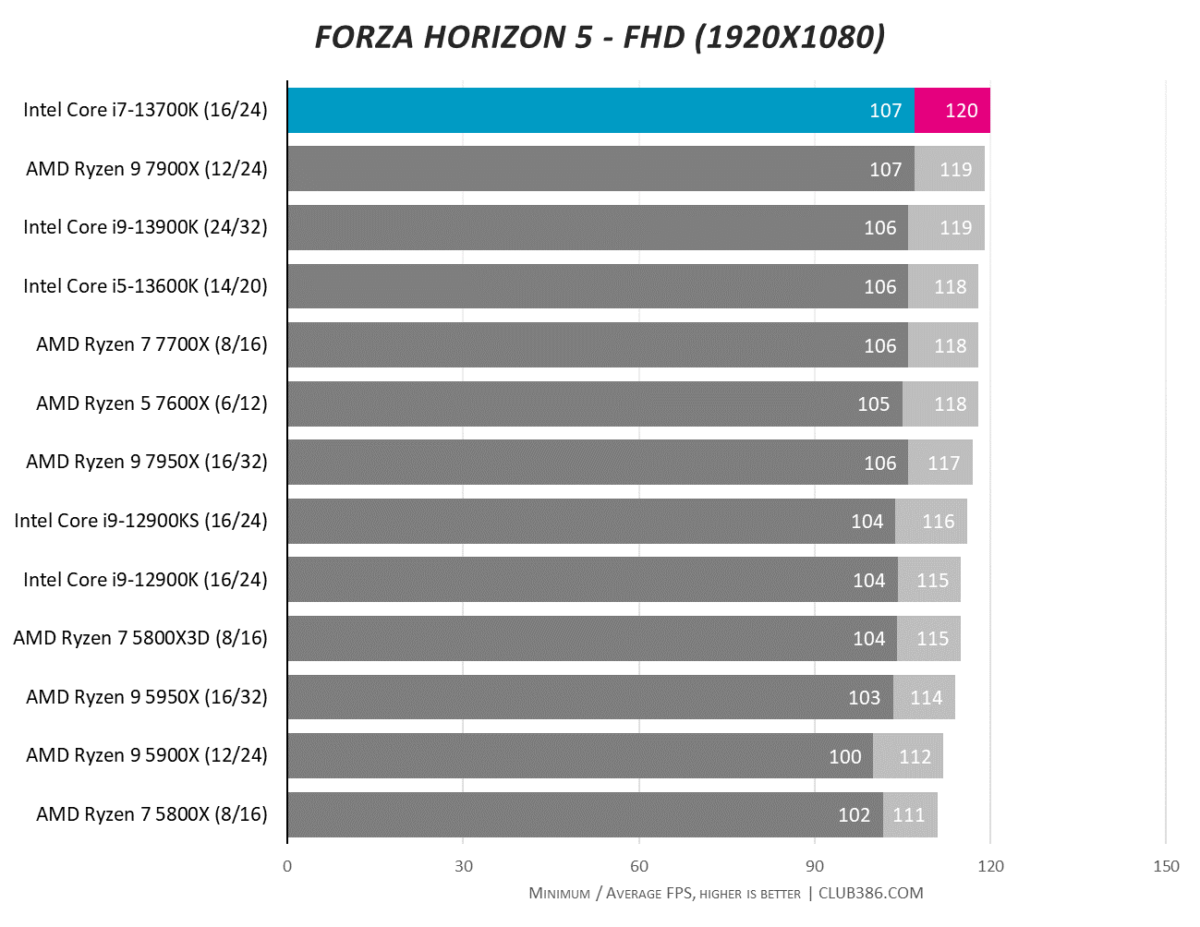
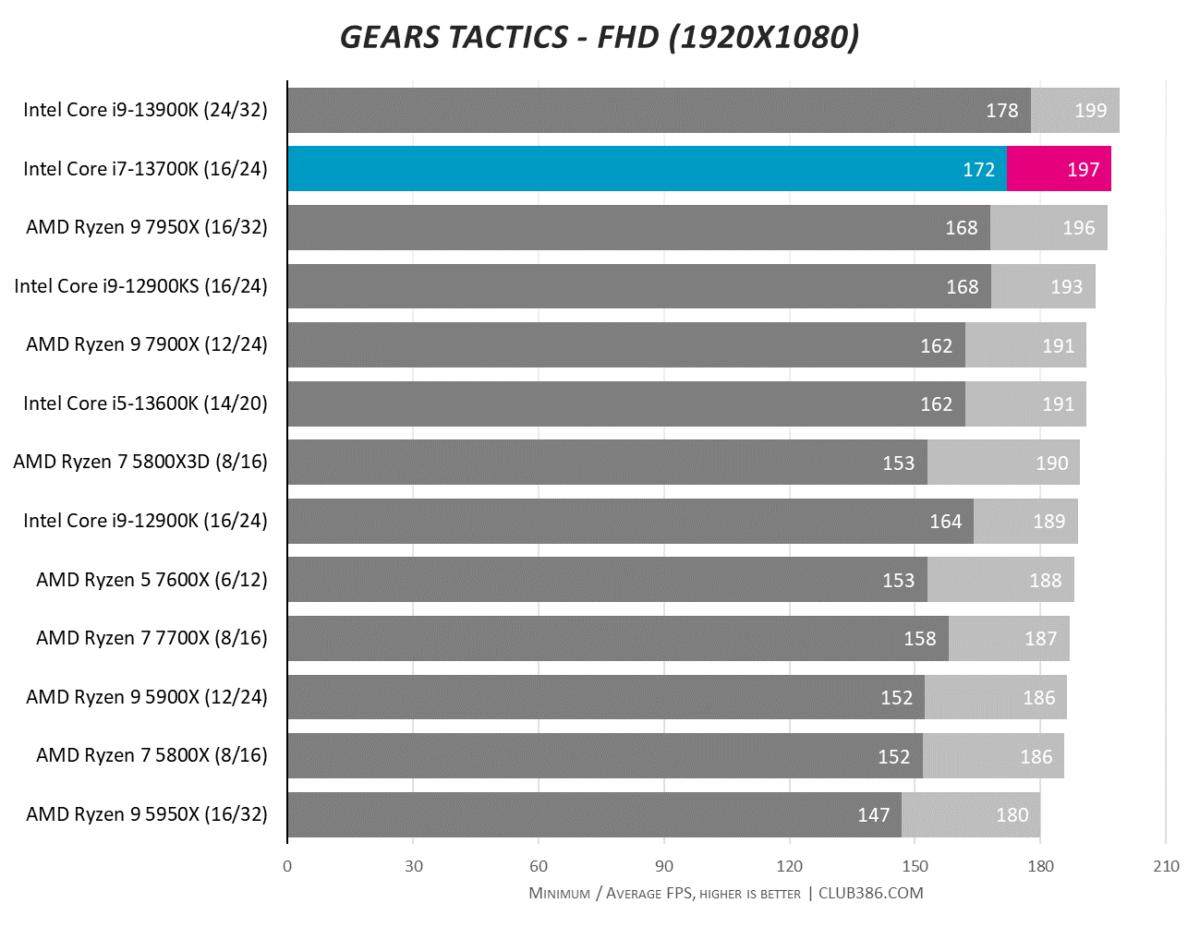
Rounding out impressive results in gaming and general applications, it’s hard not to like what Core i7-13700K has to offer.
Power, Temperature, Efficiency, Value
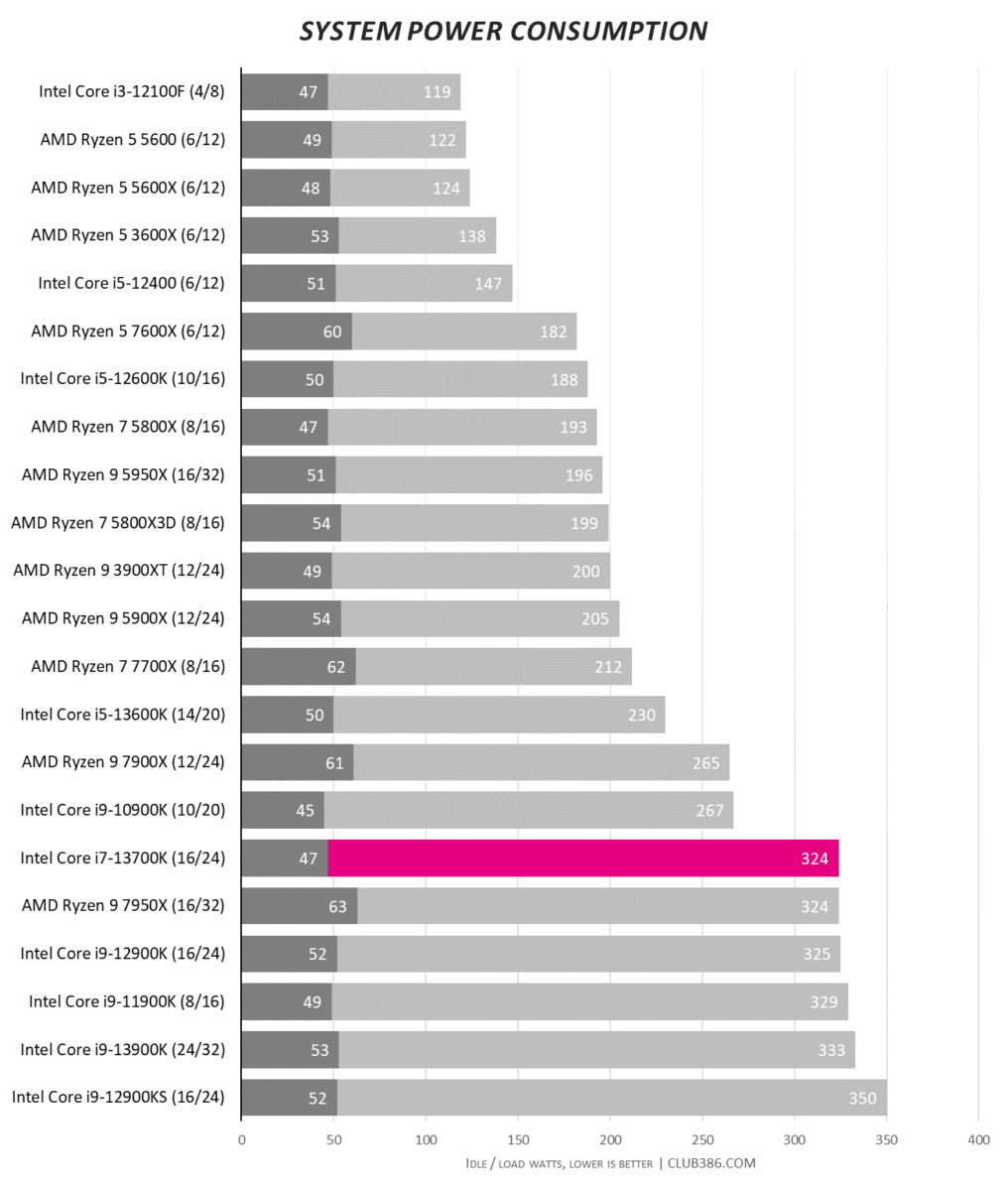
Yet here’s one downside compared to the cheaper and more power frugal Core i5-13600K that’s almost as fast. Intel fully leverages the 253W TDP and runs up to a system-wide 324W. Checking logs, the chip chomps along at an all-P-core 5.3GHz, which is only 100MHz off its peak speed. E-cores, meanwhile, manage all-core speeds of 4.2GHz, which is the same as peak.
In other words, Intel’s use of a high TDP is reflected in all-core frequencies very close to the highest turbo bins. Talk about getting the most out of your silicon.
Our Noctua NH-D15 single-fan cooler is barely man enough to tame the chip, if you’re wondering, with a maximum 90°C temperature noted during the 10-minute Cinebench R23 stability run. Anything less than a premium air cooler or decent AIO runs the risk of the processor throttling under full-bore load.
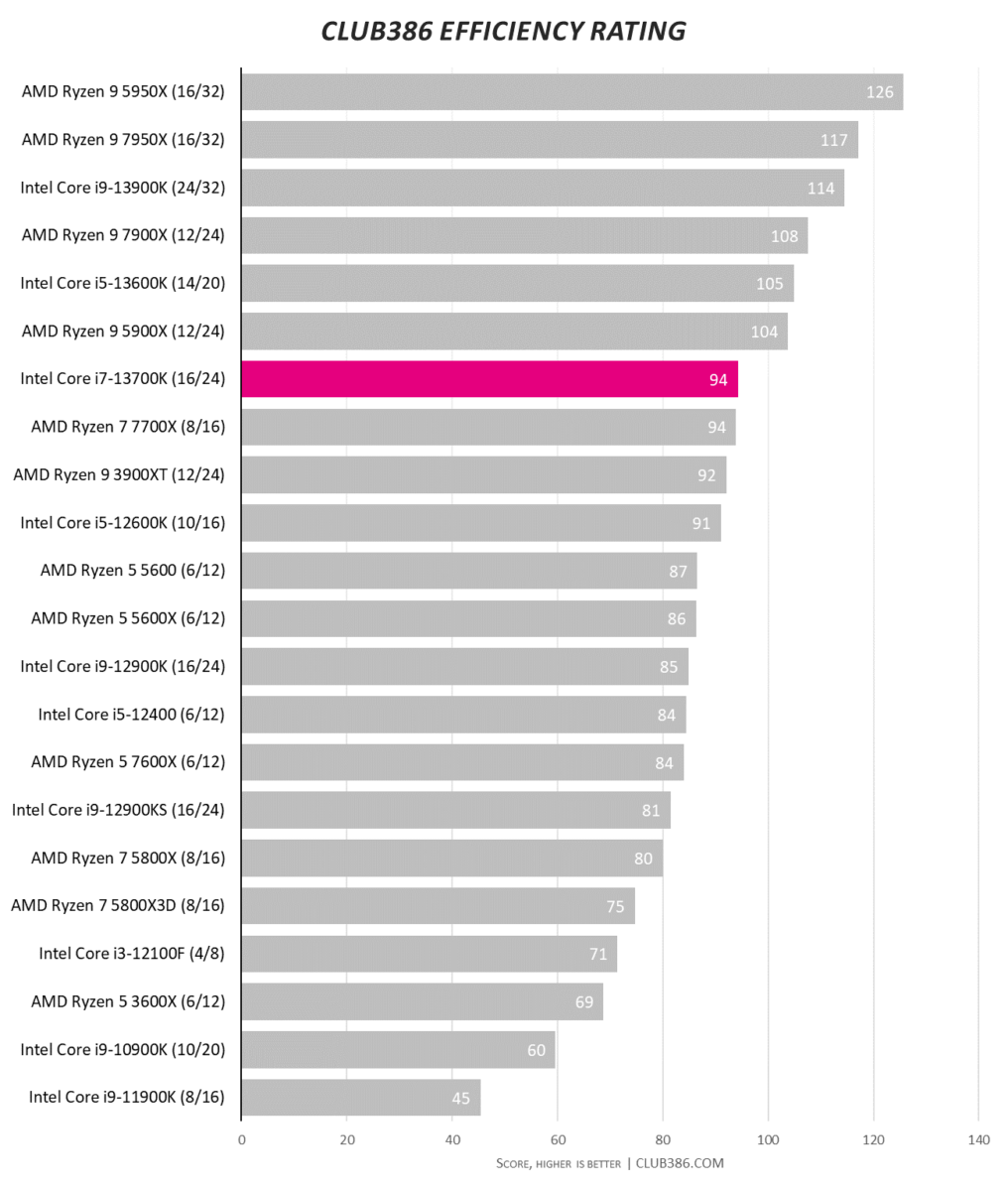
The efficiency chart divides observed Cinebench R23 multi-core score by system-wide power consumption. Even a 324W figure for the latter does little to dampen the Core i7-13700K’s appeal, such is the innate performance.
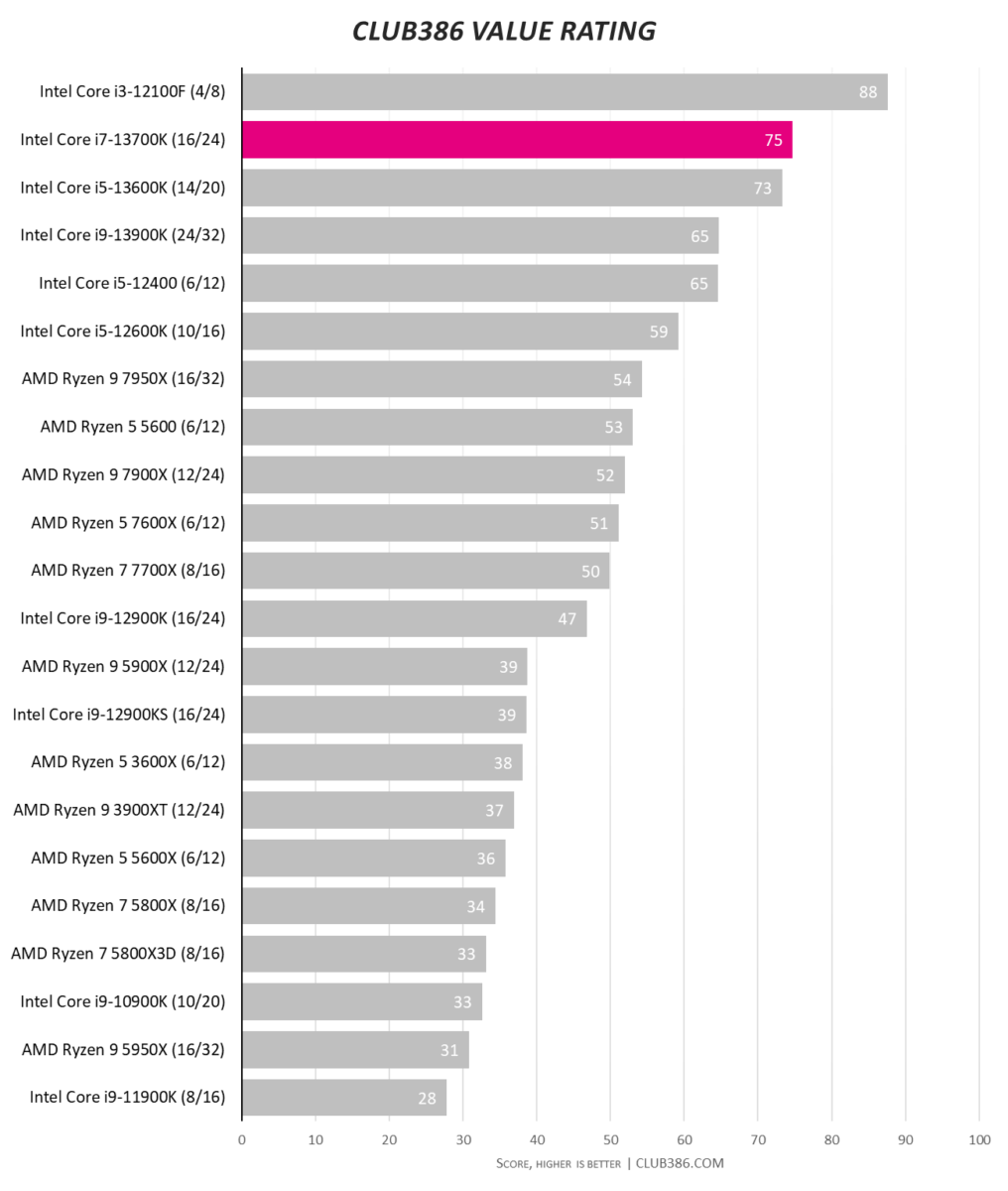
Looking even better here, the chart divides the same Cinebench R23 score by recommended dollar price. Pushing out over 30,000 marks and costing $409 is a clear recipe for success.
Overclocking
Knowing the processor hums along with P- and E-cores operating at 5.2GHz and 4.2GHz, respectively, there’s not a huge deal of scope to go faster.
Following in the same tradition as overclocking Core i9-13900K, whereby we remove all power-related limits and increase multipliers until failure, we managed 5.4GHz on P-cores and 4.4GHz for Efficient. Cinebench R23 score rose from 30,565 to 31,108 but gaming was mostly unaffected. An undesirable consequence of adding an extra 0.1V was system-wide power consumption spiked up to 406W. We’d only recommend overclocking if you’re using custom-loop cooling.
Conclusion
Intel’s relentless pursuit of desktop PC performance domination continues unabated with Core i7-13700K. Arguably better than a Core i9 from previous generations, Intel mates high thread count with wholesome frequencies on both sets of cores. Owners of the Core i9-12900KS will shake heads and wonder why they didn’t hold out six months longer.
Achieving a good metric in efficiency and a great score for value underlines how potent desktop Raptor Lake is. It takes a $549 AMD Ryzen 9 7900X to match what the $409 Core i7-13700K can deliver, while not being tied to a DDR5-only platform further helps Intel find a spot in value-focussed systems where every penny counts.
A fine CPU in its own right for gaming and multi-core applications, only stablemate Core i5-13600K stops the review chip from becoming our favourite 13th Gen Core processor so far. Recommended.
Verdict: Intel Raptor Lake continues to impress with another stellar chip.

